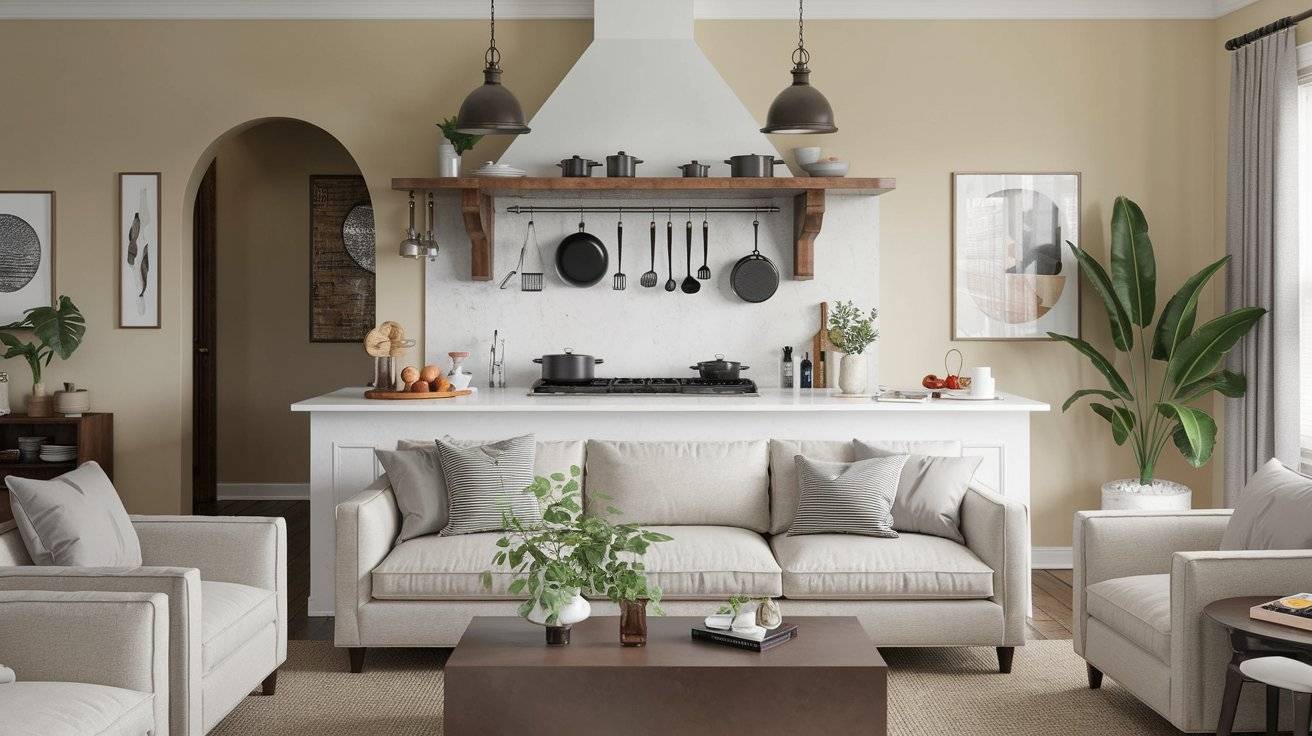An open kitchen seamlessly connected to the living room creates a spacious, welcoming, and functional environment. This design choice enhances interaction, increases natural light flow, and makes the space feel larger.
Whether you’re design a new home or remodeling, these 30 smart ways will help you craft the perfect open-concept kitchen-living room.
30. Use a Unified Color Palette
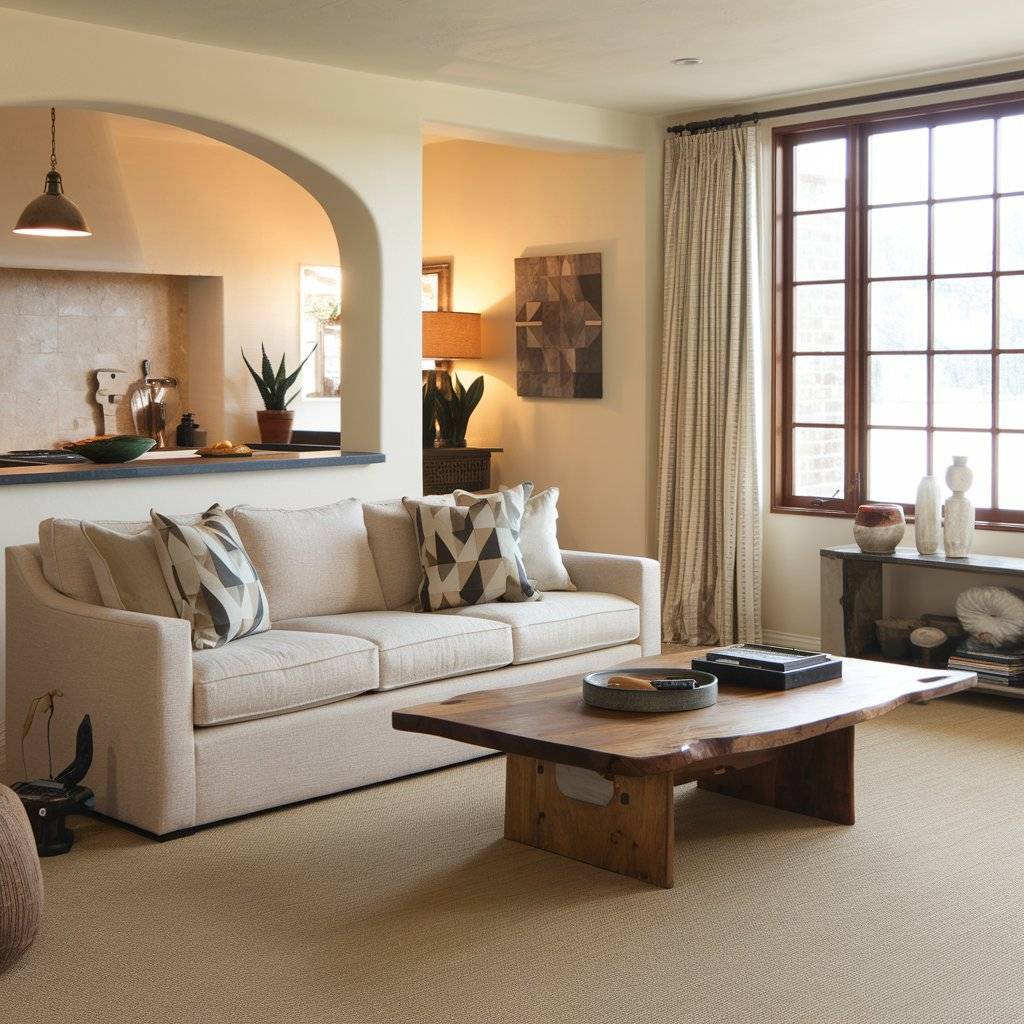
A cohesive color scheme ensures a smooth transition between the kitchen and living room. Neutral tones with pops of complementary colors create harmony while maintaining distinct spaces.
Stick to a base color that ties both areas together, such as a neutral or dominant shade. Incorporate accents through decor, textiles, or small furniture pieces to add depth.
Maintain balance by repeating key shades in both spaces for a cohesive look. Consider lighting, as both natural and artificial sources can affect how colors appear, so test swatches before committing.
A cohesive color scheme ensures a smooth transition between the kitchen and living room.
Amazon Affiliate Link: Best Paint Colors for Open-Concept Spaces
Technical Details:
- Recommended colors: Neutral tones (white, beige, gray) with accent hues
- Paint types: Matte, satin, or semi-gloss finishes
- Suitable for: Small to large open-concept spaces
29. Define Spaces with Flooring
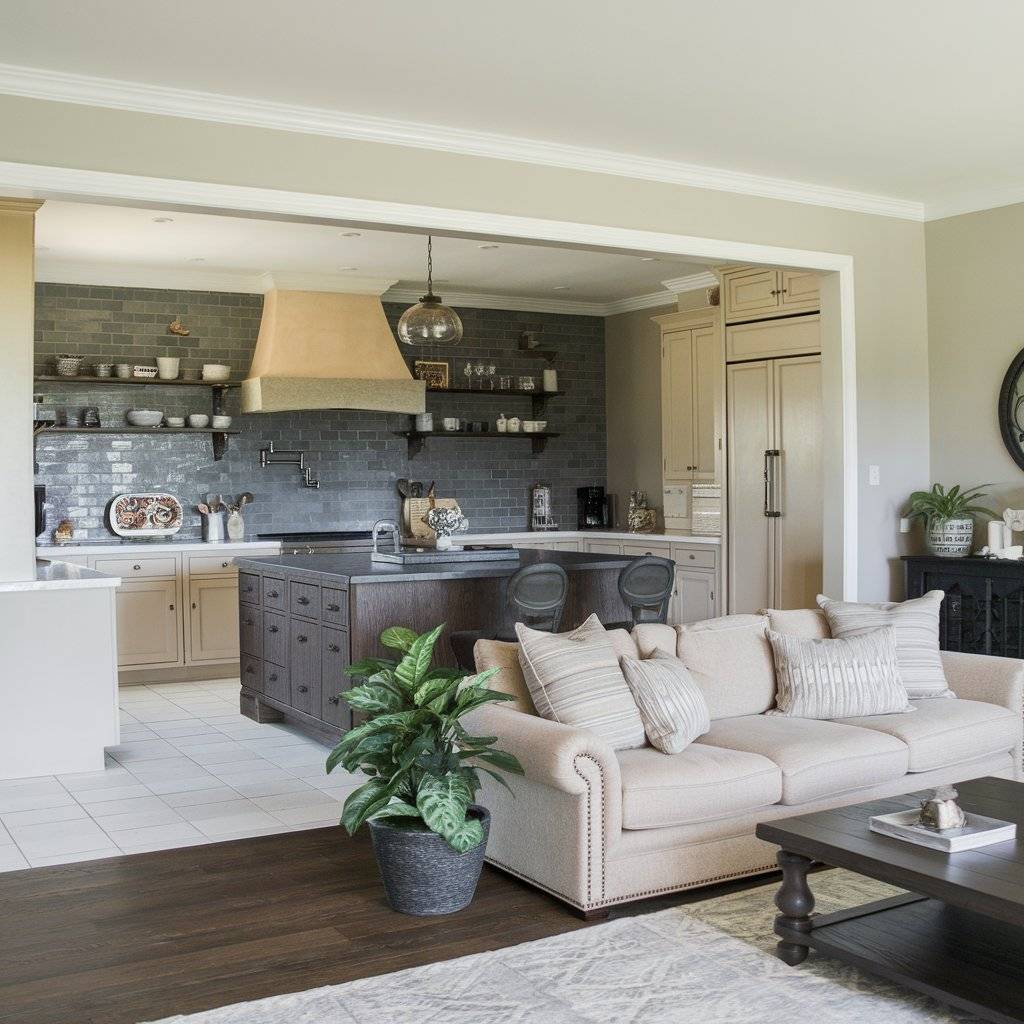
Using different but complementary flooring materials helps distinguish the kitchen from the living room. Tiles in the kitchen and wood flooring in the living area can create a natural yet subtle division.
Using different but complementary flooring materials helps distinguish the kitchen from the living room.
Amazon Affiliate Link: Top Flooring Options for Open Kitchens
Product Information
- Flooring types: Hardwood, tile, vinyl, laminate
- Installation: Professional or DIY-friendly options available
- Durability: High-traffic resistance recommended
28. Opt for an Open-Shelf Concept
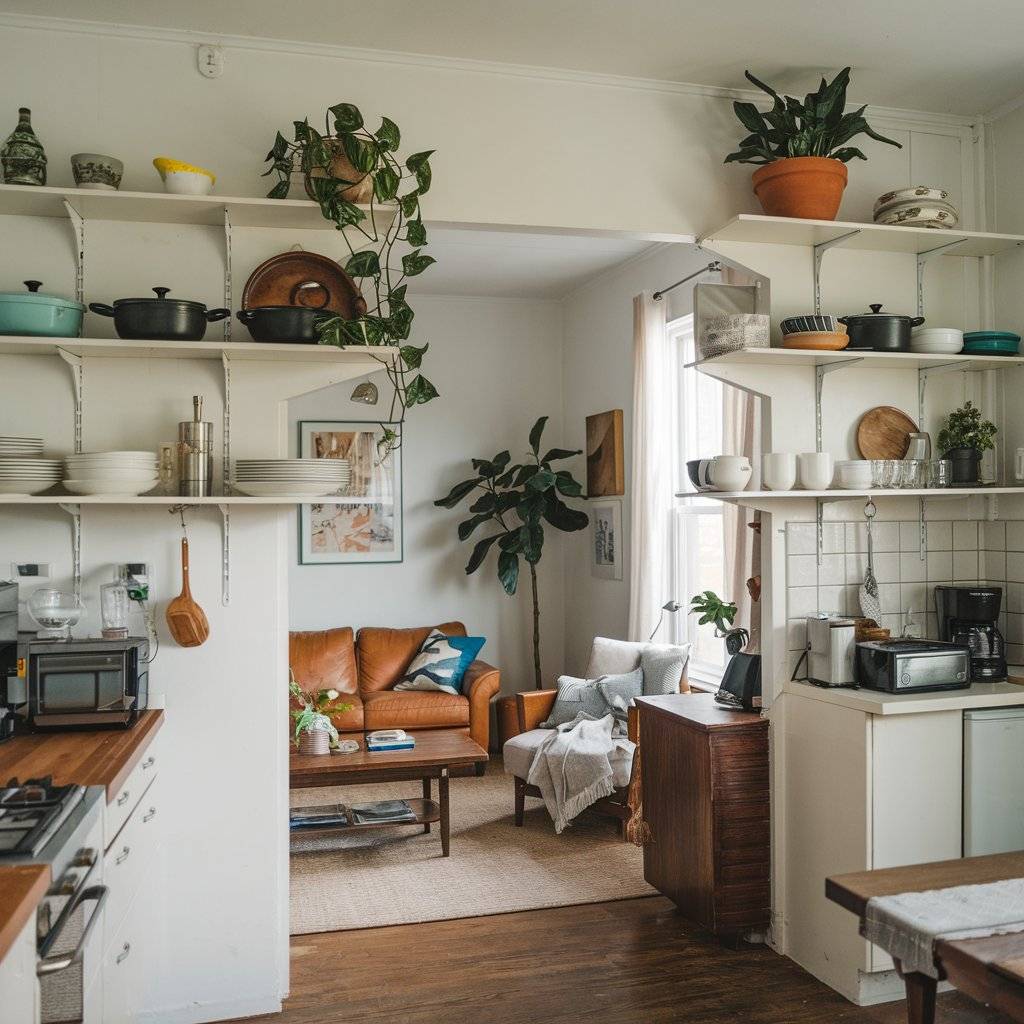
Open shelves between the kitchen and living room create a sense of openness while providing additional storage and display options.
This design allows for easy access to everyday essentials while showcasing decorative pieces, plants, or dishware. It also enhances natural light flow, making both spaces feel brighter and more connected.
To keep the area visually appealing, opt for a balanced mix of functional and decorative items, and use uniform containers or baskets to reduce clutter
Open shelves create openness while providing additional storage and display options.
Amazon Affiliate Link: Best Floating Shelves for Kitchens
Technical Details:
- Materials: Wood, metal, glass
- Load capacity: Ensure sturdy brackets for weight support
- Maintenance: Regular dusting and organization required
27. Utilize a Multi-Functional Kitchen Island
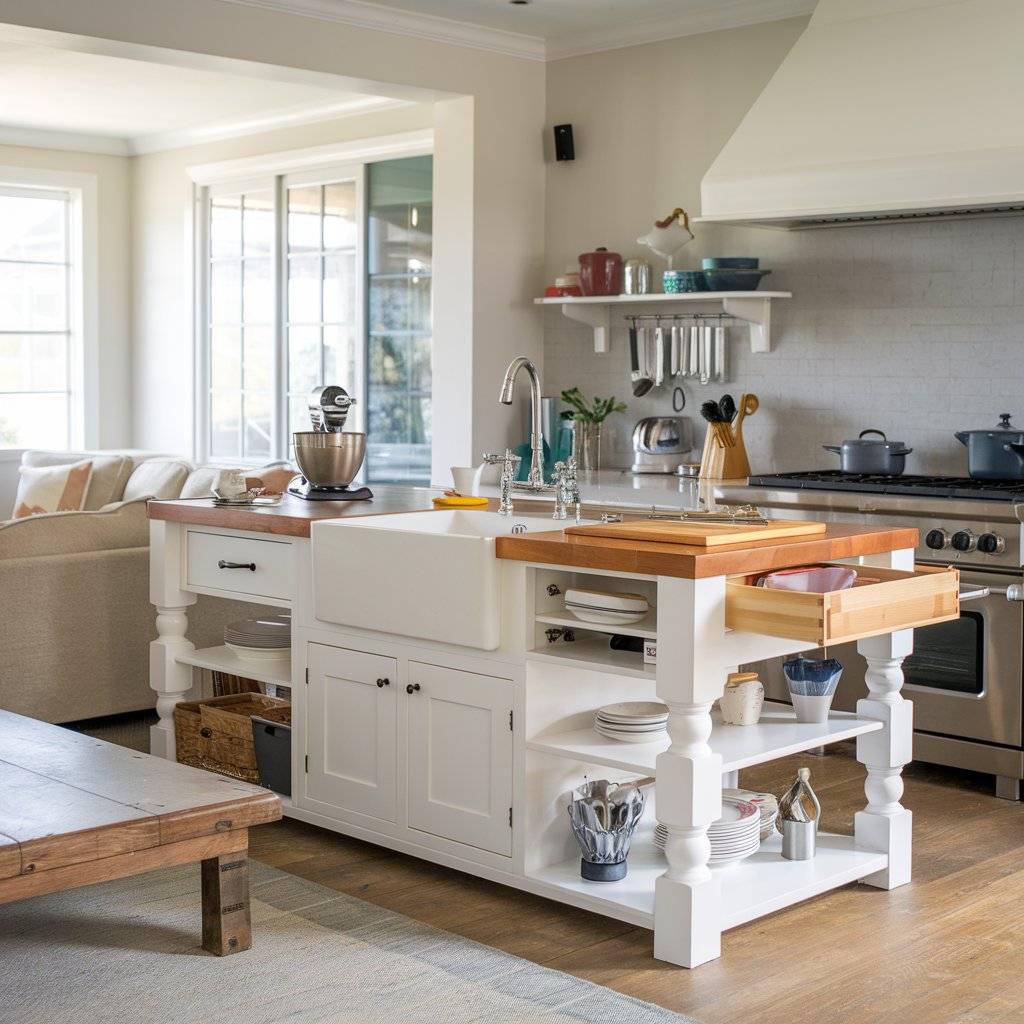
A well-designed kitchen island can significantly enhance both the functionality and aesthetics of your space. It can serve as a food prep station, a casual dining area, and additional storage for cookware, utensils, or small appliances.
Some islands even incorporate built-in sinks, dishwashers, or wine racks, making them an all-in-one solution for busy kitchens.
Opting for a movable or expandable island can also add flexibility, allowing you to adapt the space to your needs.
A well-designed kitchen island can serve as a prep station, dining area, and storage space.
Amazon Affiliate Link: Top-Rated Kitchen Islands
Product Information:
- Materials: Quartz, granite, butcher block, marble
- Features: Storage cabinets, seating space, electrical outlets
- Customization: Modular or fixed installation options
26. Install Sliding or Glass Partition Doors
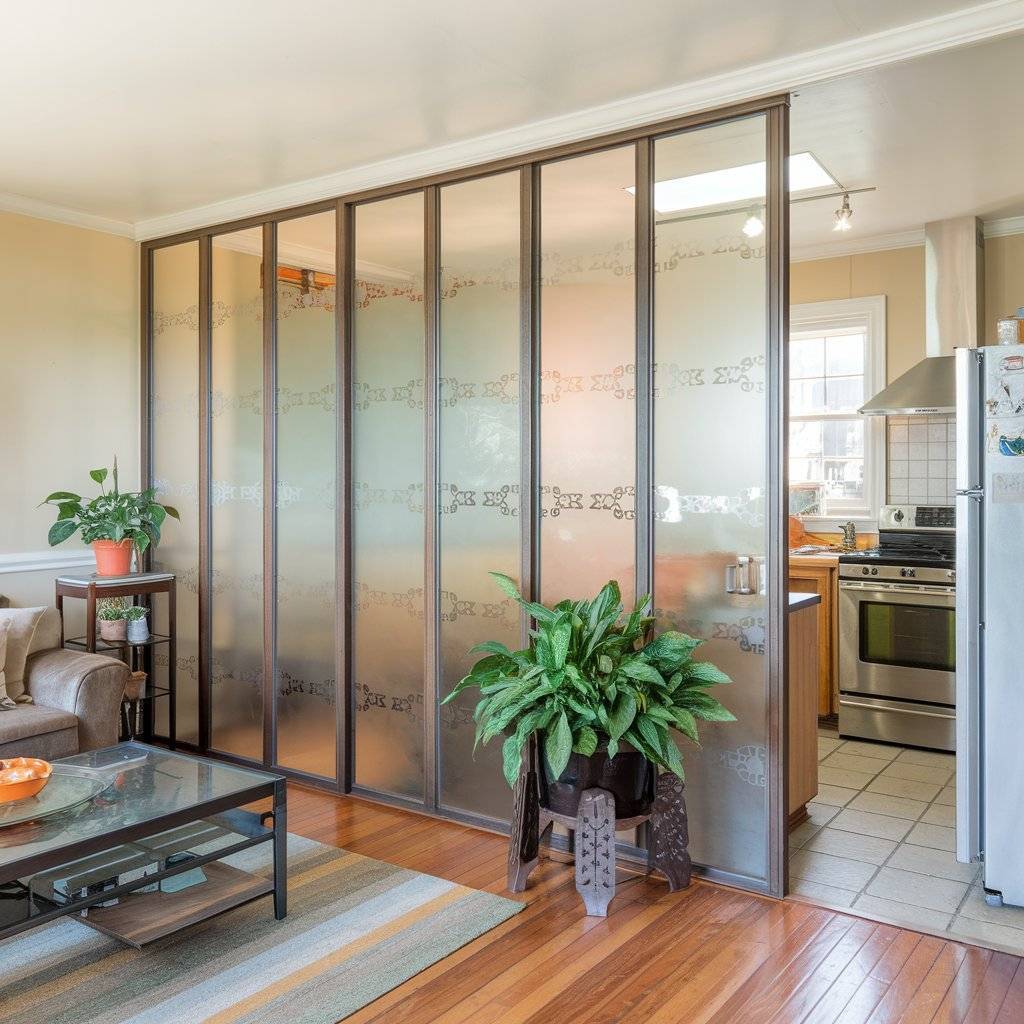
If you prefer a semi-open concept, glass or sliding partitions provide flexibility by allowing openness when needed while offering privacy when necessary.
Glass partitions provide flexibility for semi-open concepts.
Amazon Affiliate Link: Best Glass Room Dividers
Product Information:
- Types: Frameless glass, frosted glass, wooden sliding doors
- Mechanism: Track-mounted or pocket doors
- Space-saving: Ideal for flexible separation
25. Incorporate a Breakfast Bar
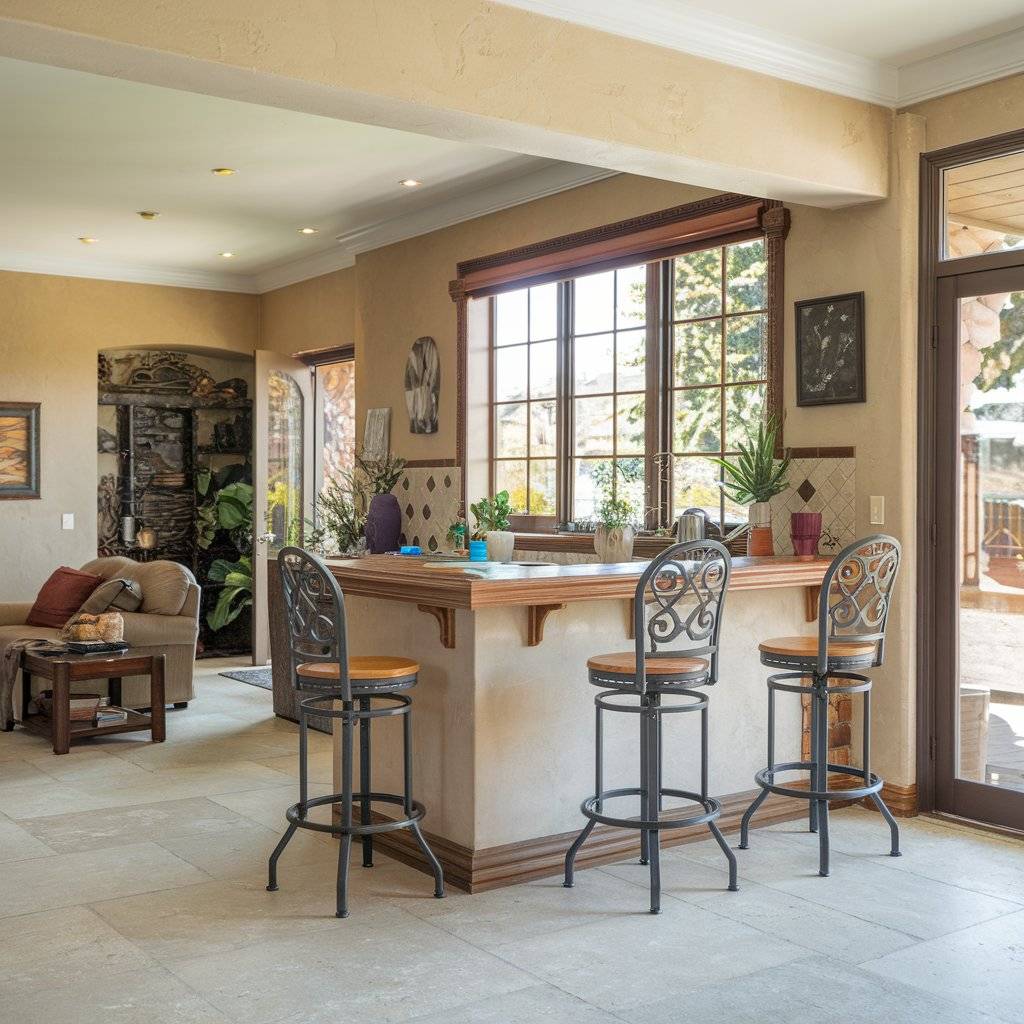
A well-designed breakfast bar it enhance both style and practicality in your kitchen. It serves as a versatile spot for quick meals, socializing, or even working from home.
Opt for a design that complements your kitchen layout whether it’s an extended countertop, a kitchen island addition, or a wall-mounted ledge. Pair it with comfortable stools and adequate lighting to create a cozy and inviting space.
A breakfast bar enhances style and practicality. Amazon Affiliate Link: Best Bar Stools for Kitchen Counters
Technical Details:
- Materials: Wood, stone, metal
- Height: Standard bar height 42 inches
- Seating: Stools or chairs with proper ergonomic support
Also here Related post: small Kitchen apartment design ideas for this year
24. Add a Statement Lighting Fixture
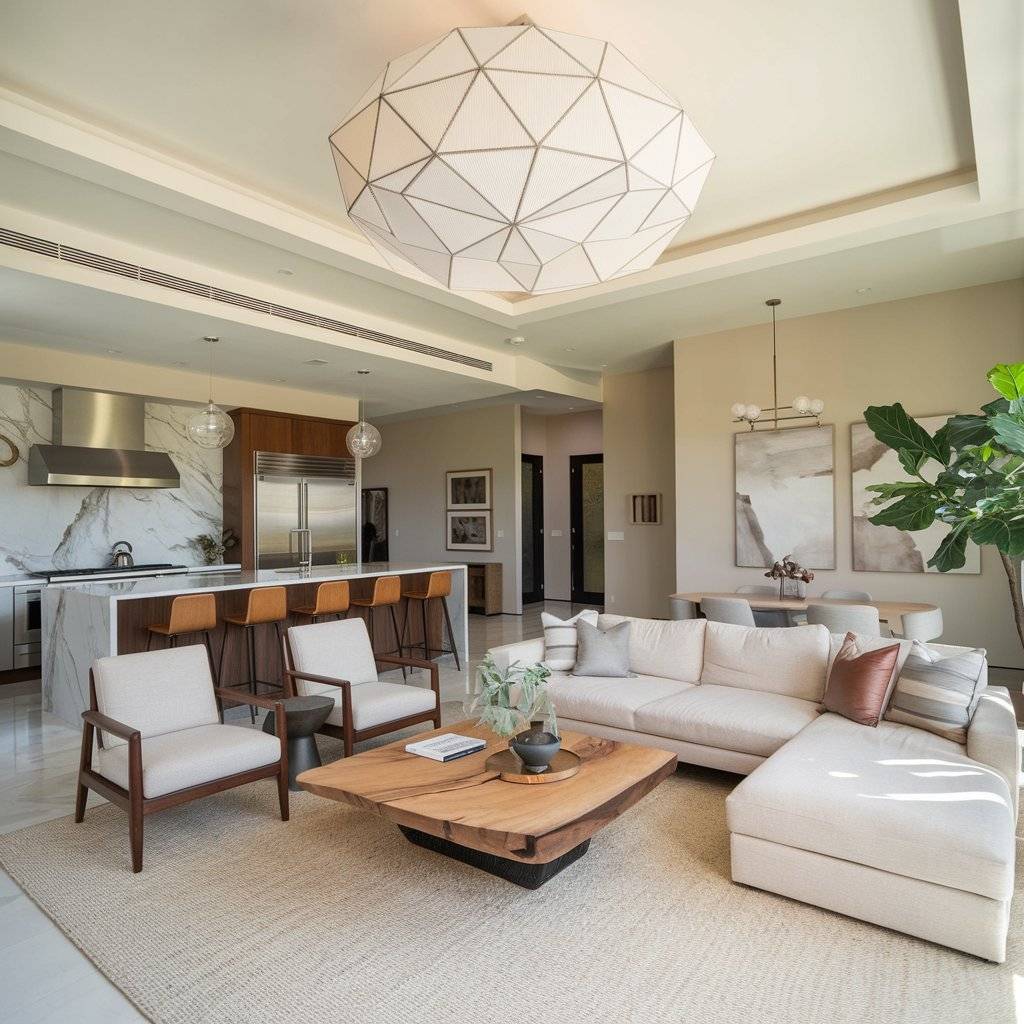
Pendant lights, chandeliers, or recessed lighting can create visual cohesion while defining distinct areas. Pendant lights, chandeliers, or recessed lighting can create visual cohesion while defining distinct areas.
Choose a bold or uniquely designed fixture can serve as a focal point, adding personality and enhancing the ambiance of the space. Consider dimmable options for versatility or layered lighting to create depth and warmth in your decor.
Pendant lights, chandeliers, or recessed lighting can create visual cohesion.
Amazon Affiliate Link: Top Pendant Lights for Kitchens
Technical Details:
- Types: Chandeliers, pendant lights, recessed lighting
- Power: LED energy-efficient options
- Placement: Above kitchen islands, dining areas
23. Use Furniture to Create Separation
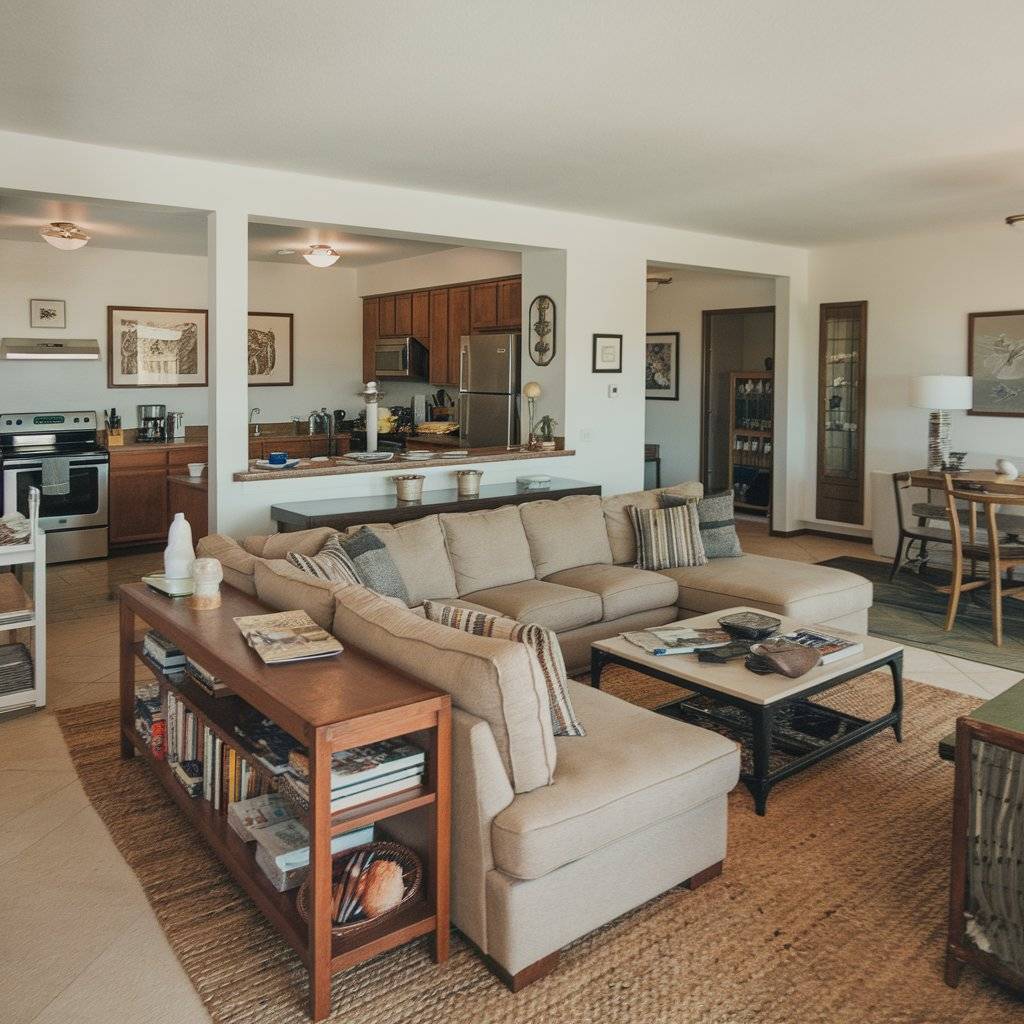
Strategic furniture placement, such as a sectional sofa or bookshelf, can naturally define different zones within an open space. You can use furniture to create distinct areas without the need for walls.
A well-placed console table behind a sofa can separate the living area from a dining space, while an open back bookshelf provides both storage and a subtle division.
Rugs and varying furniture heights can also help establish boundaries, making each zone feel intentional and functional.
Strategic furniture placement can define different zones without walls.
Amazon Affiliate Link: Best Sectional Sofas for Open Spaces
Product Information & Technical Details:
- Types: Sectional sofas, bookshelves, console tables
- Material: Wood, metal, fabric upholstery
- Functionality: Dual-purpose furniture for storage and seating
22. Install a Two-Sided Fireplace
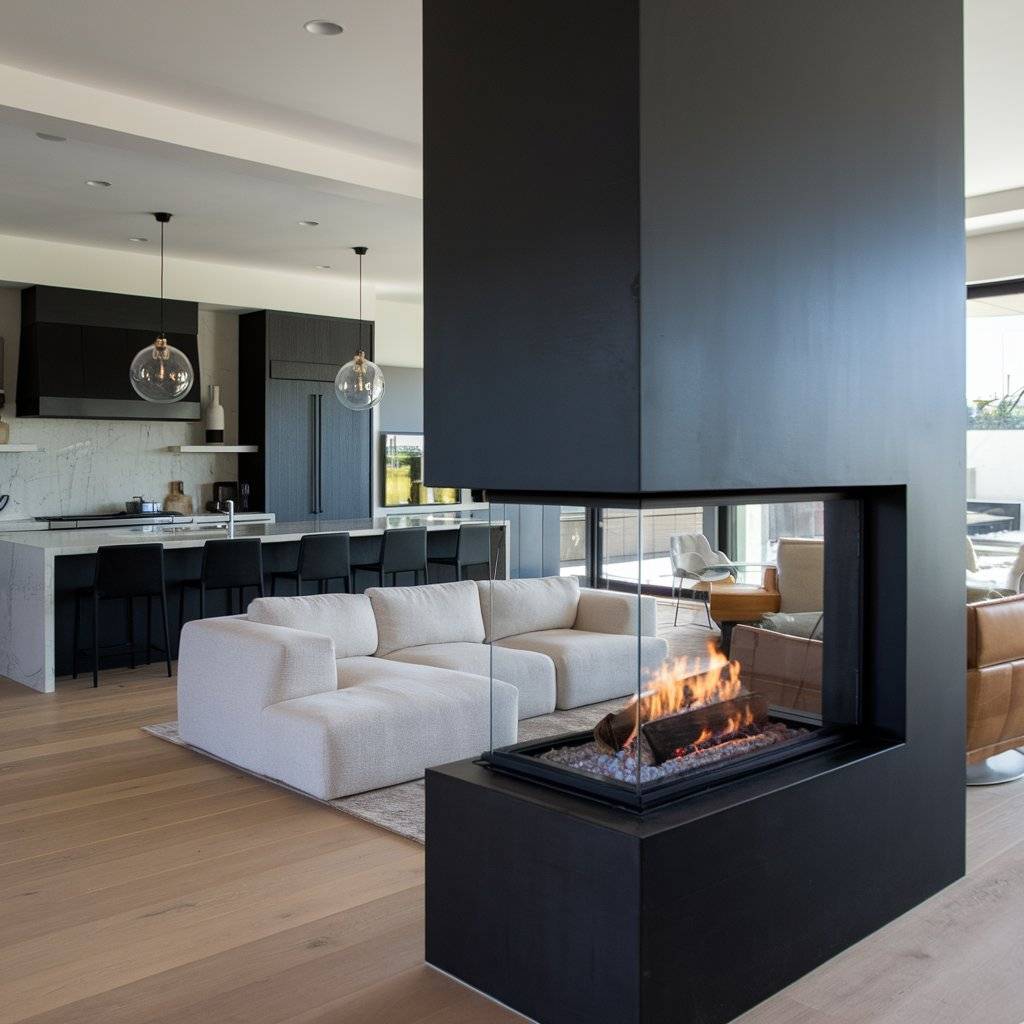
A double-sided fireplace acts as a stunning focal point and subtly separates the kitchen from the living area while maintaining openness.
A two-sided fireplace not only enhances the ambiance but also provides warmth to two spaces at once. This design is perfect for open-concept homes, allowing you to enjoy the cozy glow from both the kitchen and living area.
Available in gas, wood-burning, or electric options, these fireplaces add elegance and efficiency, making your space feel inviting and luxurious.
A double-sided fireplace acts as a stunning focal point.
Amazon Affiliate Link: Best Electric Fireplaces
Product Information
- Types: Gas, electric, wood-burning
- Material: Stone, brick, metal
- Efficiency: Energy-saving features available
21. Extend Kitchen Countertops Into the Living Room
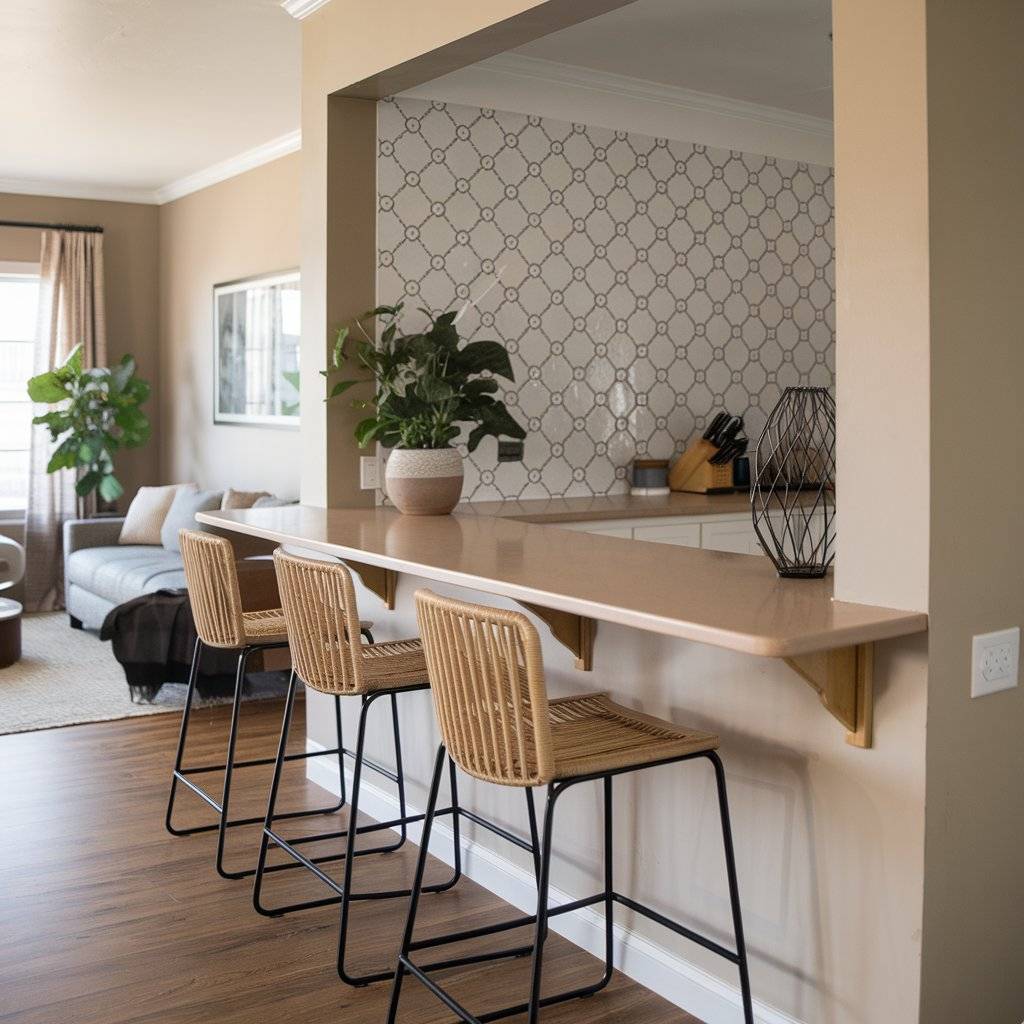
By extending the kitchen counter, you create a built-in dining space that connects both areas. This design not only enhances the flow between the kitchen and living room but also maximizes functionality.
A countertop extension can serve as a casual dining area, a workspace, or even a display surface for décor. It’s an excellent solution for open-concept homes, making the space feel more cohesive while improving usability.
A countertop extension connects both areas seamlessly.
Amazon Affiliate Link: Best Countertop Extension Kits
Technical Details:
- Materials: Granite, quartz, laminate
- Design: Seamless integration with living space
- Maintenance: Regular sealing for stone countertops
20. Incorporate Natural Elements
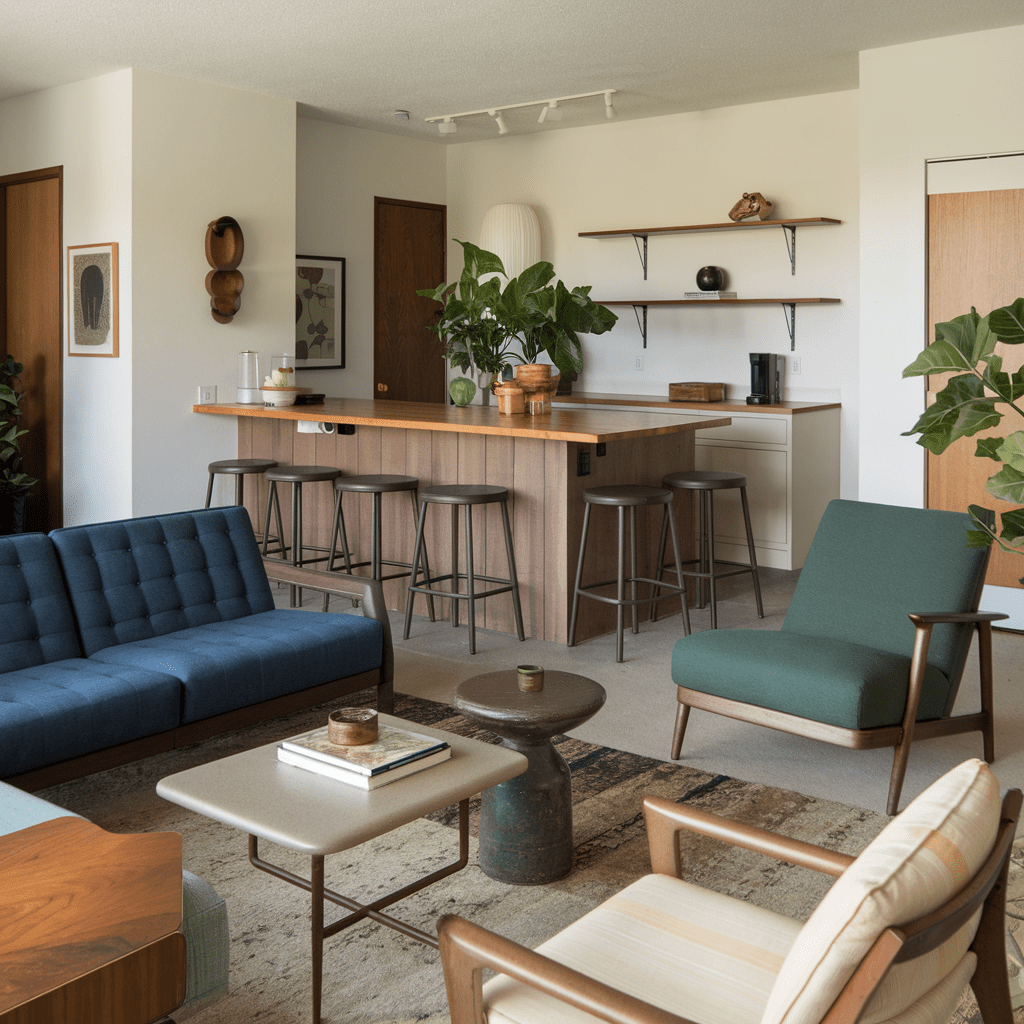
Using materials such as wood, stone, and metal ensures a seamless flow between the two spaces while adding warmth and texture.
Using wood, stone, and metal adds warmth and texture.
Amazon Affiliate Link: Best Wooden Accents for Kitchens
Product Information
- Materials: Wood, stone, bamboo
- Sustainability: Eco-friendly sourcing options available
- Aesthetic: Enhances warmth and texture
19. Opt for Consistent Cabinetry and Furniture Style
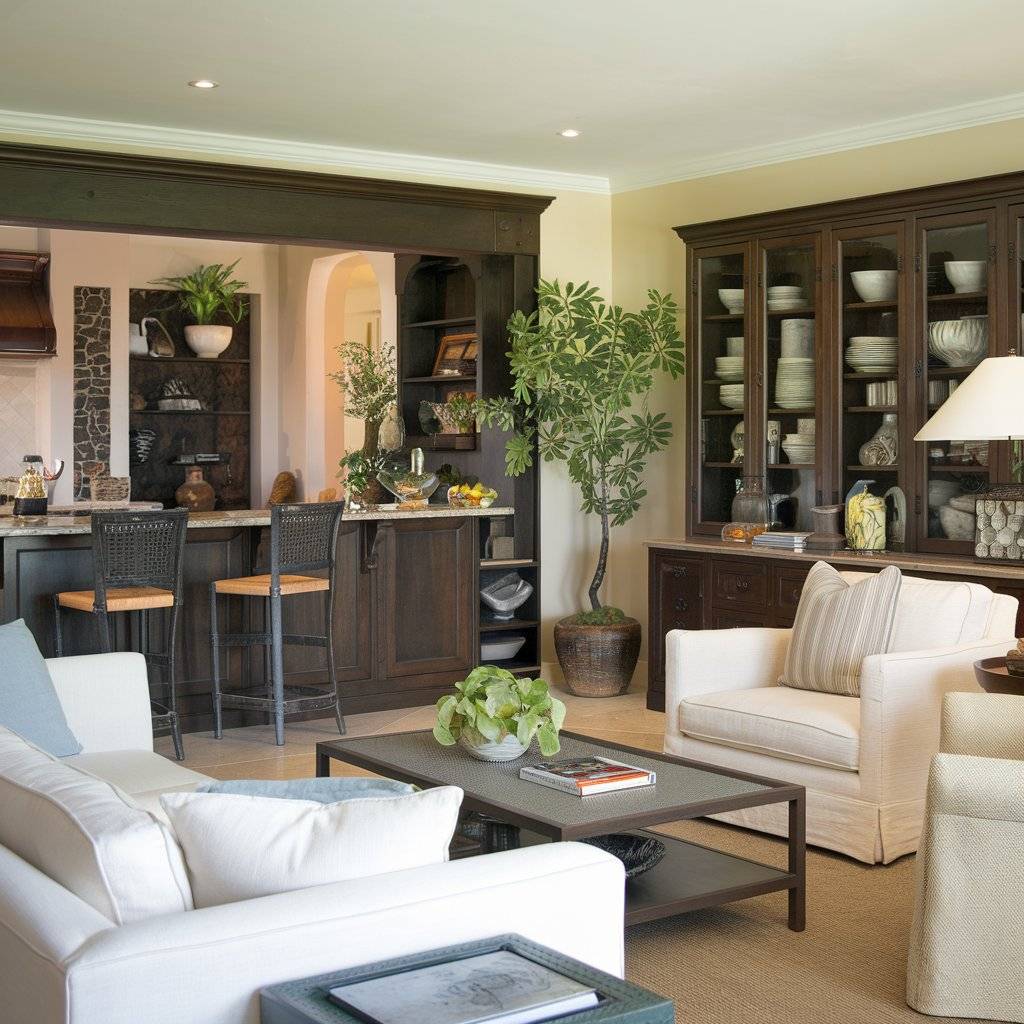
A cohesive look between the kitchen and living room can be achieved by choosing cabinetry and furniture with matching materials, colors, or design elements.
Whether you prefer modern, rustic, or traditional styles, maintaining consistency in wood tones, hardware, or finishes enhances the seamless transition between the two areas, creating a well-integrated and harmonious space.
Matching cabinetry and furniture styles create a cohesive look.
Amazon Affiliate Link: Top Kitchen Cabinets
Product Information & Technical Details:
- Materials: MDF, hardwood, metal
- Finishes: Glossy, matte, painted, stained
- Hardware: Handles, knobs, or push-to-open designs
18. Use Rugs to Define Areas
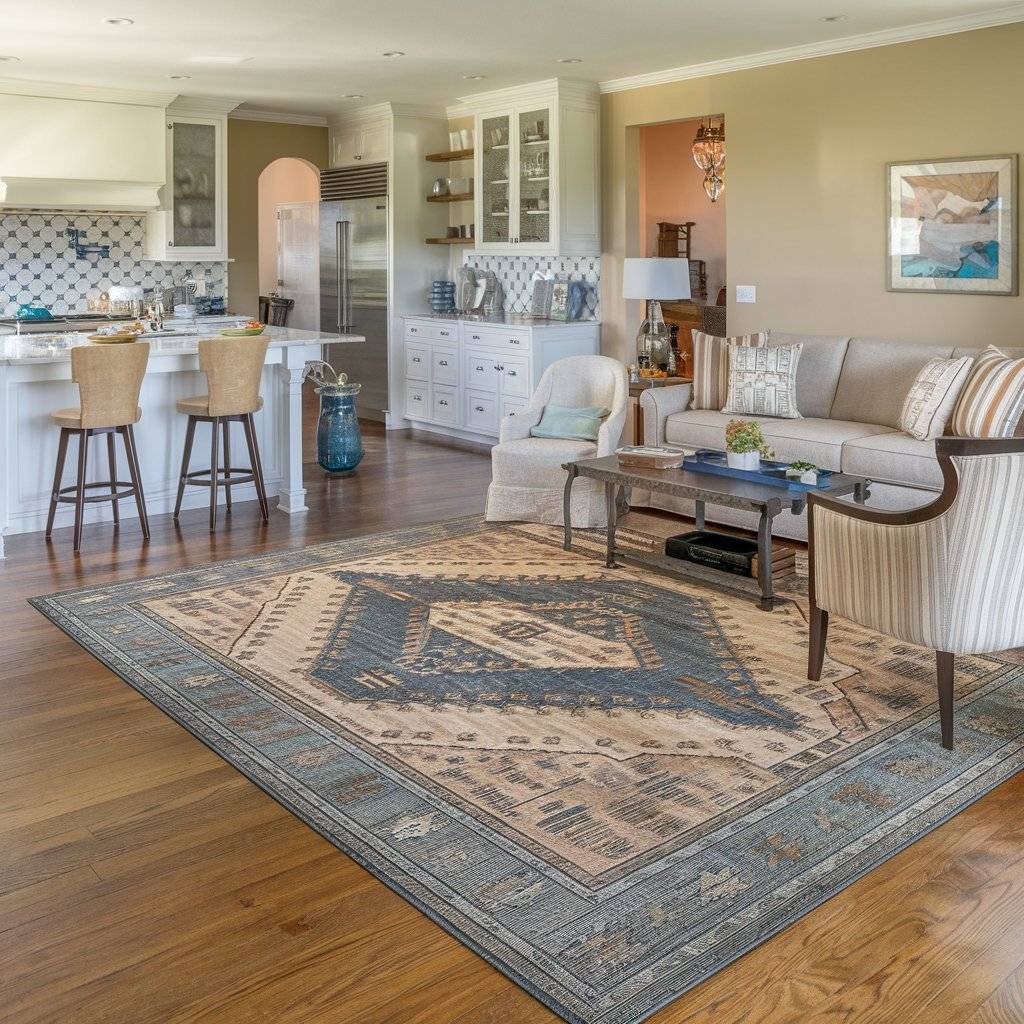
A well-placed rug can help visually separate the living room from the kitchen while adding warmth and texture. In open-concept spaces, rugs act as subtle dividers, creating distinct zones without the need for walls.
They also enhance comfort underfoot and contribute to the overall design by introducing color, pattern, and cohesion to a room. Choose a rug size that fits your furniture arrangement to maintain balance and harmony in your space
Rugs can visually separate the living room from the kitchen.
Amazon Affiliate Link: Best Area Rugs for Open Spaces
- Materials: Wool, synthetic, cotton
- Sizes: Varies based on room dimensions
- Maintenance: Vacuuming and occasional deep cleaning
17. Integrate Smart Storage Solutions
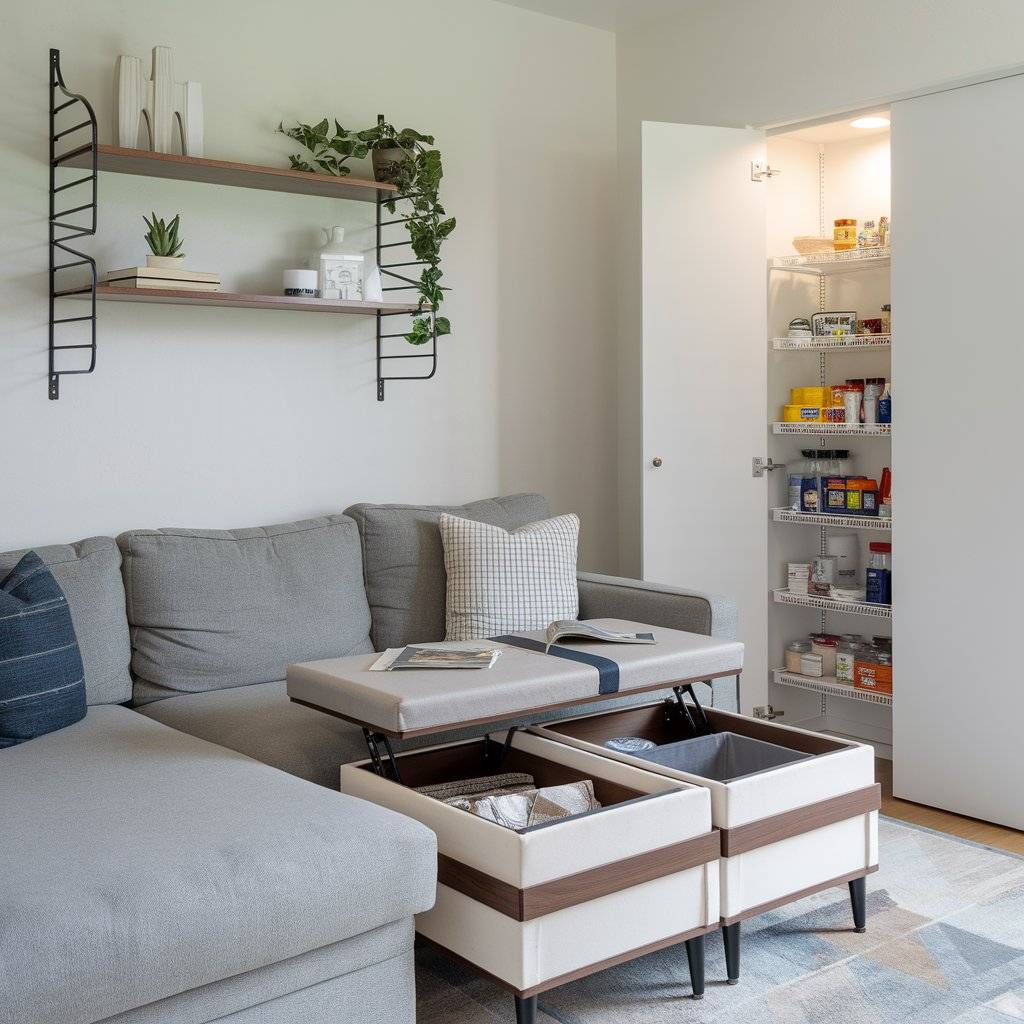
Maximize vertical space and utilize hidden storage solutions to keep both the kitchen and living room clutter-free.
Install wall-mounted shelves, pull-out pantry racks, and multi-functional furniture like ottomans with hidden compartments.
Use drawer dividers and stackable containers to optimize cabinet space. By incorporating these smart storage ideas, you can create a more organized and visually appealing home.
Maximize vertical space and use hidden storage solutions.
Amazon Affiliate Link: Best Kitchen Storage Organizers
Technical Details:
- Storage Types: Built-in cabinets, wall-mounted shelves, under-counter storage
- Organization: Modular shelving, pull-out drawers
- Space-saving: Ideal for compact layouts
16. Maximize Natural Light
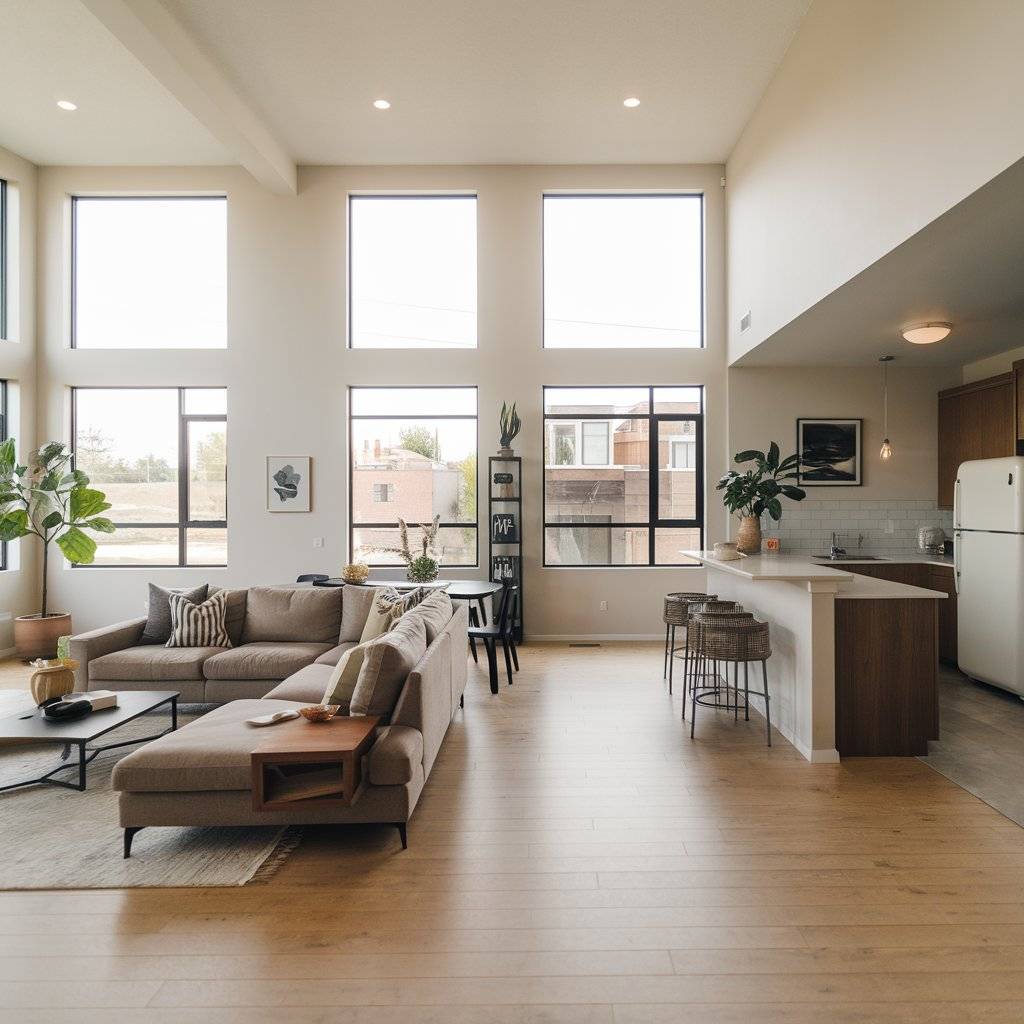
Use large windows, glass doors, and minimal window treatments to allow natural light to flood both areas, making the space feel larger and more connected.
Use large windows, glass doors, and minimal window treatments.
Amazon Affiliate Link: Best Sheer Curtains for Natural Light
Technical Details:
- Window Types: Floor-to-ceiling, skylights, sliding glass doors
- Treatment: Sheer curtains, blinds, tinting
- Energy Efficiency: Double-glazed glass for insulation
15. Design a Continuous Backsplash

Extending the kitchen backsplash into the living area creates a sense of continuity and enhances visual flow. A continuous backsplash can be achieved by using the same material, such as tile, stone, or glass, across both spaces. This design trick not only unifies the look of an open-concept home but also adds a stylish and cohesive backdrop.
A backsplash that extends into the living area creates continuity.
Amazon Affiliate Link: Top-Rated Peel-and-Stick Backsplash
Product Information & Technical Details:
- Materials: Ceramic tile, glass, stone, metal
- Cleaning: Easy-to-wipe surfaces
- Installation: Professional or DIY kits available
14. Use Ceiling Design for Subtle Separation
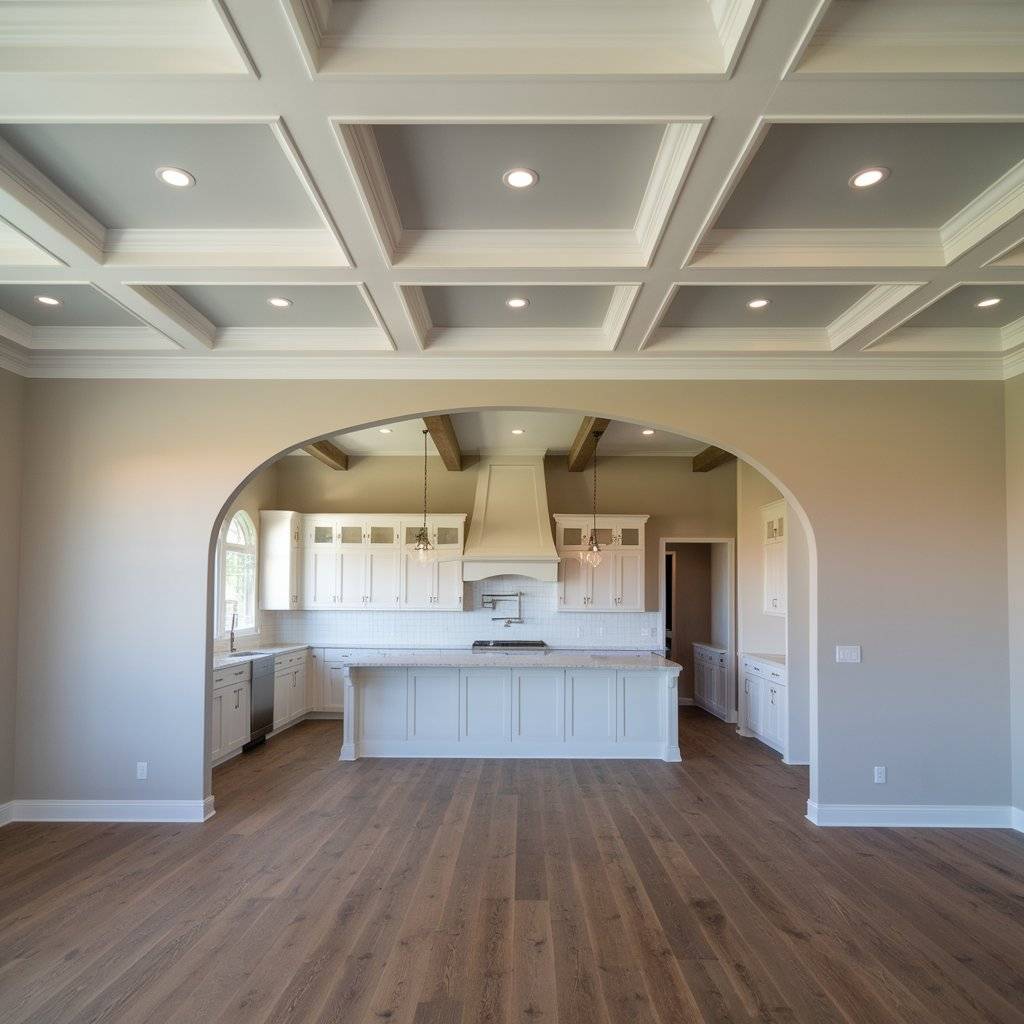
Incorporating beams, different ceiling heights, or molding details helps define spaces while maintaining openness. Coffered or tray ceilings can visually distinguish areas like the dining room from the living space without the need for walls.
Similarly, exposed wooden beams or recessed lighting can create a sense of division while adding architectural interest. This approach enhances spatial definition without compromising the flow of an open-concept design.
Beams, different ceiling heights, or molding details define spaces.
Amazon Affiliate Link: Best Ceiling Beams for Homes
Product Information
- Options: Coffered, beamed, recessed lighting
- Materials: Wood, plaster, metal
- Function: Defines areas while maintaining openness
13. Incorporate Greenery and Plants
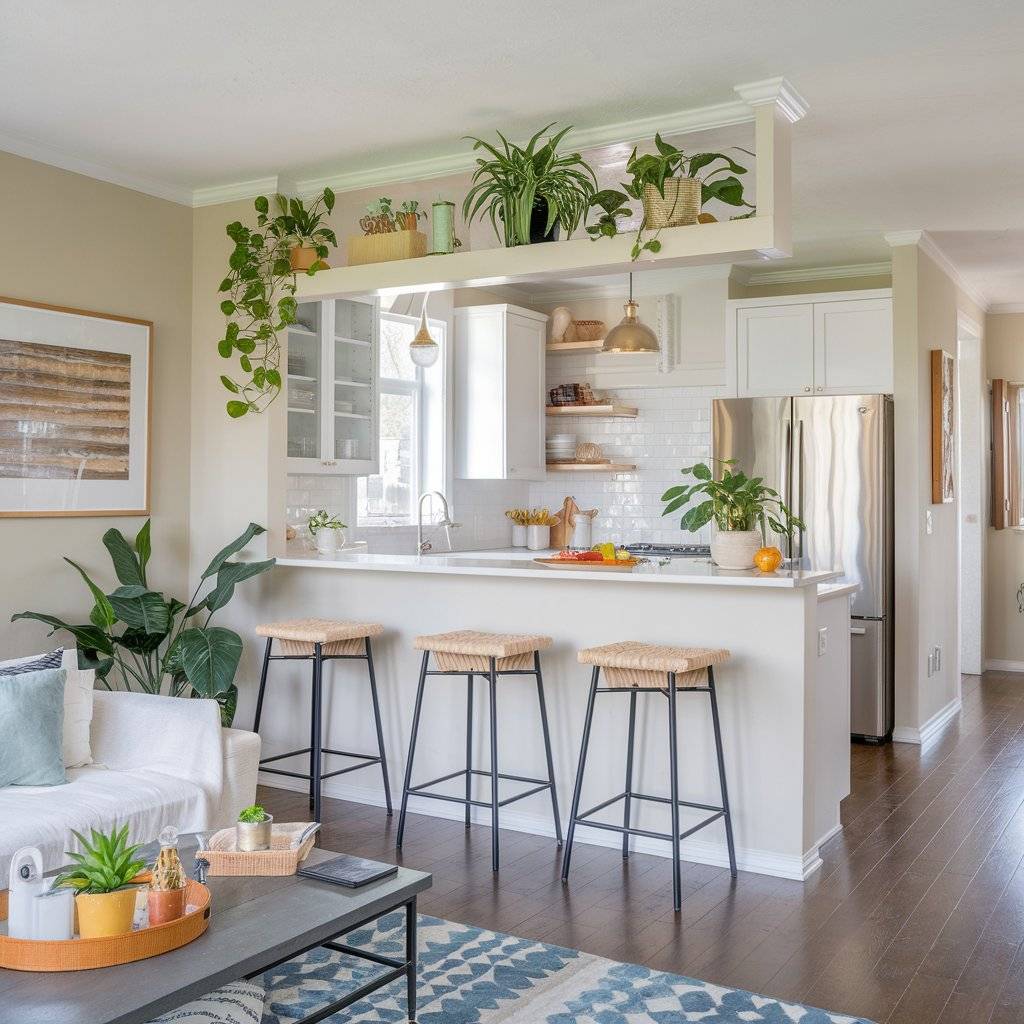
Add plants in both areas creates a seamless transition and introduces natural vibrancy to the space.A half wall is a great way to create subtle divisions in an open floor plan without sacrificing light or visibility.
It can act as a visual barrier between functional areas, such as separating a kitchen from a living room or a dining space from a hallway. This design element maintains an airy, open feel while providing structure and organization to the space.
Adding plants introduces natural vibrancy to the space.
Amazon Affiliate Link: Best Indoor Plants
Technical Details:
- Plants: Indoor-friendly species such as pothos, ferns, succulents
- Placement: Hanging, potted, built-in planters
- Care: Low-maintenance watering schedules
12. Utilize a Half Wall
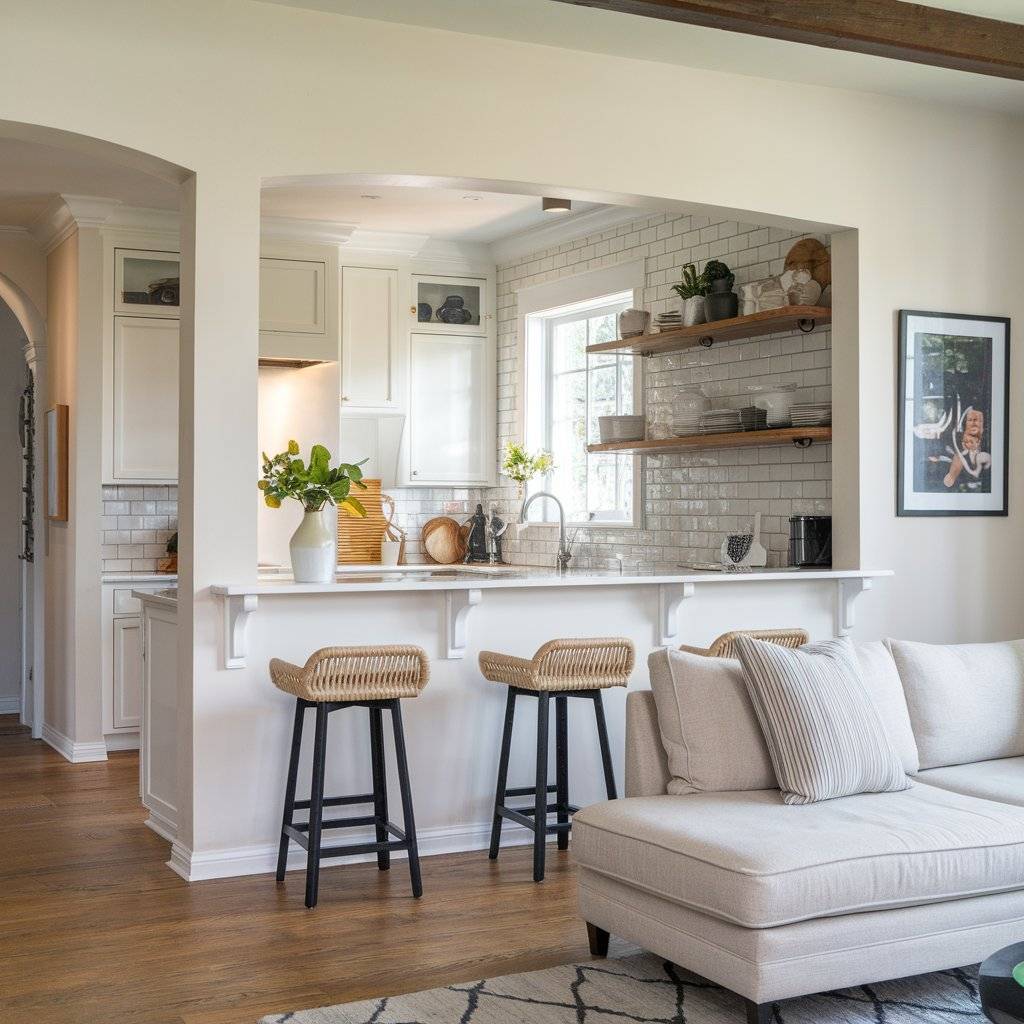
A low or half wall can define separate spaces while keeping the open-concept feel intact. A half wall is a great way to create subtle divisions in an open floor plan without sacrificing light or visibility.
It can act as a visual barrier between functional areas, such as separating a kitchen from a living room or a dining space from a hallway.
A low or half wall defines spaces while keeping an open feel.
Amazon Affiliate Link: Best Room Divider Panels
Technical Details:
- Materials: Drywall, brick, wood paneling
- Height: Typically 3-4 feet
- Design: Decorative trims or built-in shelving
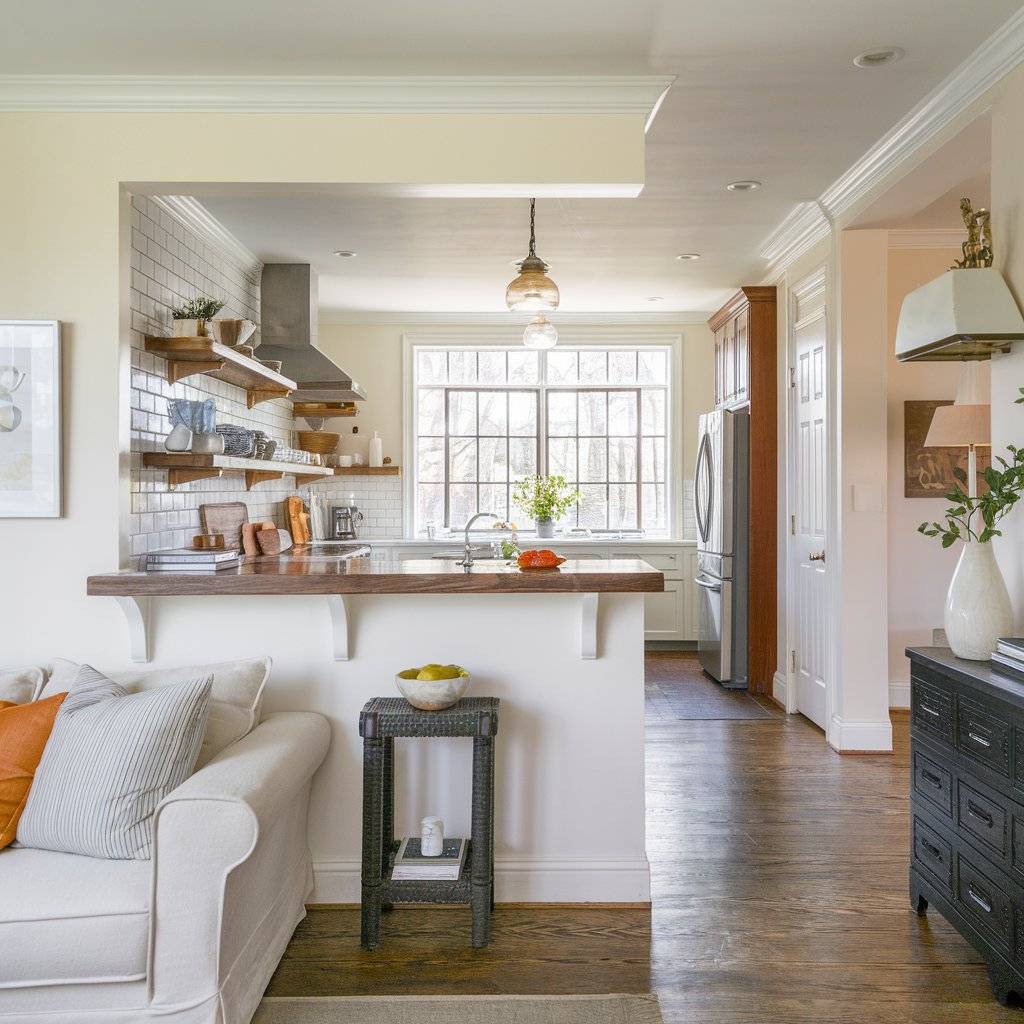
11. Design an Open Pantry
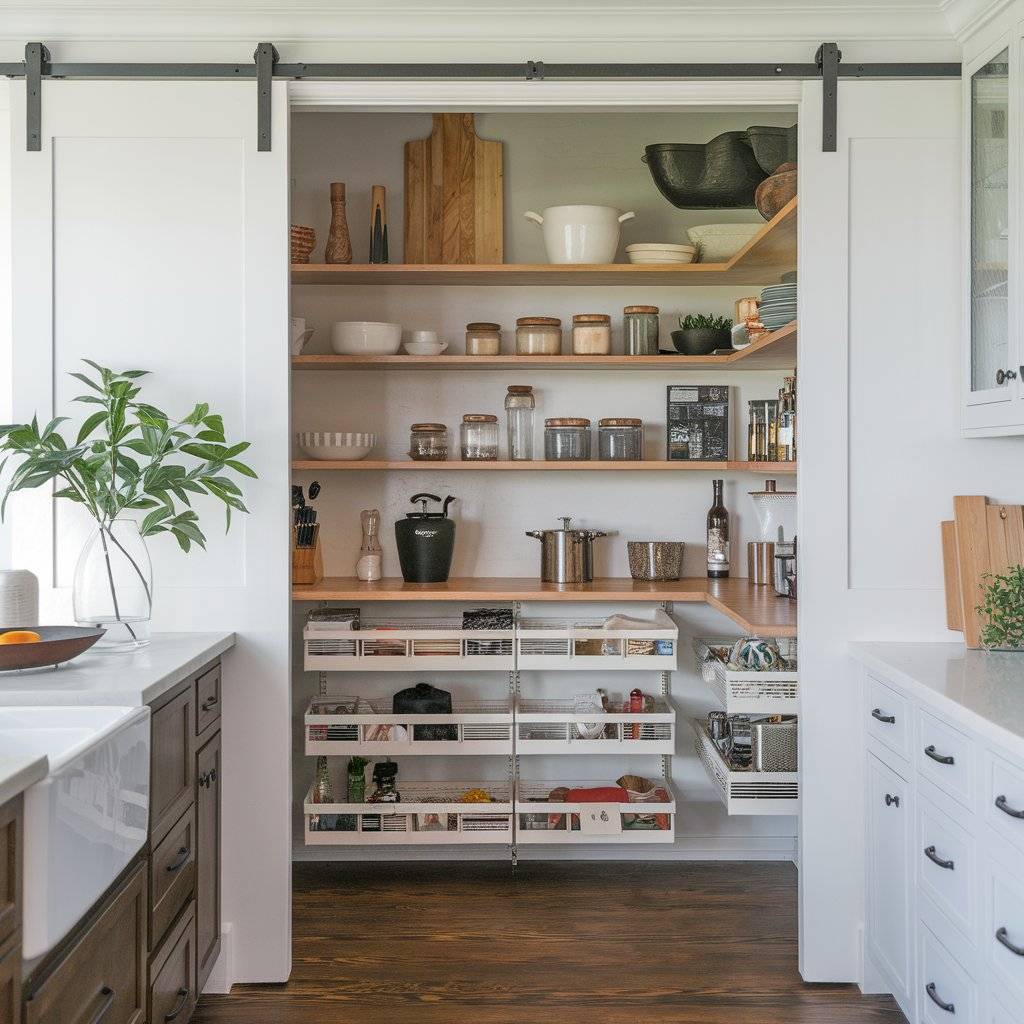
An open pantry blends effortlessly into an open kitchen-living concept while keeping essentials within easy reach. Utilize open shelving, glass containers, and labeled bins to maintain organization and visual appeal.
This setup not only enhances accessibility but also creates an inviting, curated look that complements modern and rustic kitchen designs alike. Consider adding sliding doors or curtains for flexibility in concealing clutter when needed.
An open pantry blends effortlessly into an open-concept home.
Amazon Affiliate Link: Best Pantry Organizers
Technical Details:
- Shelving: Adjustable, built-in, floating shelves
- Organization: Baskets, labeled containers
- Visibility: Easy access to stored goods
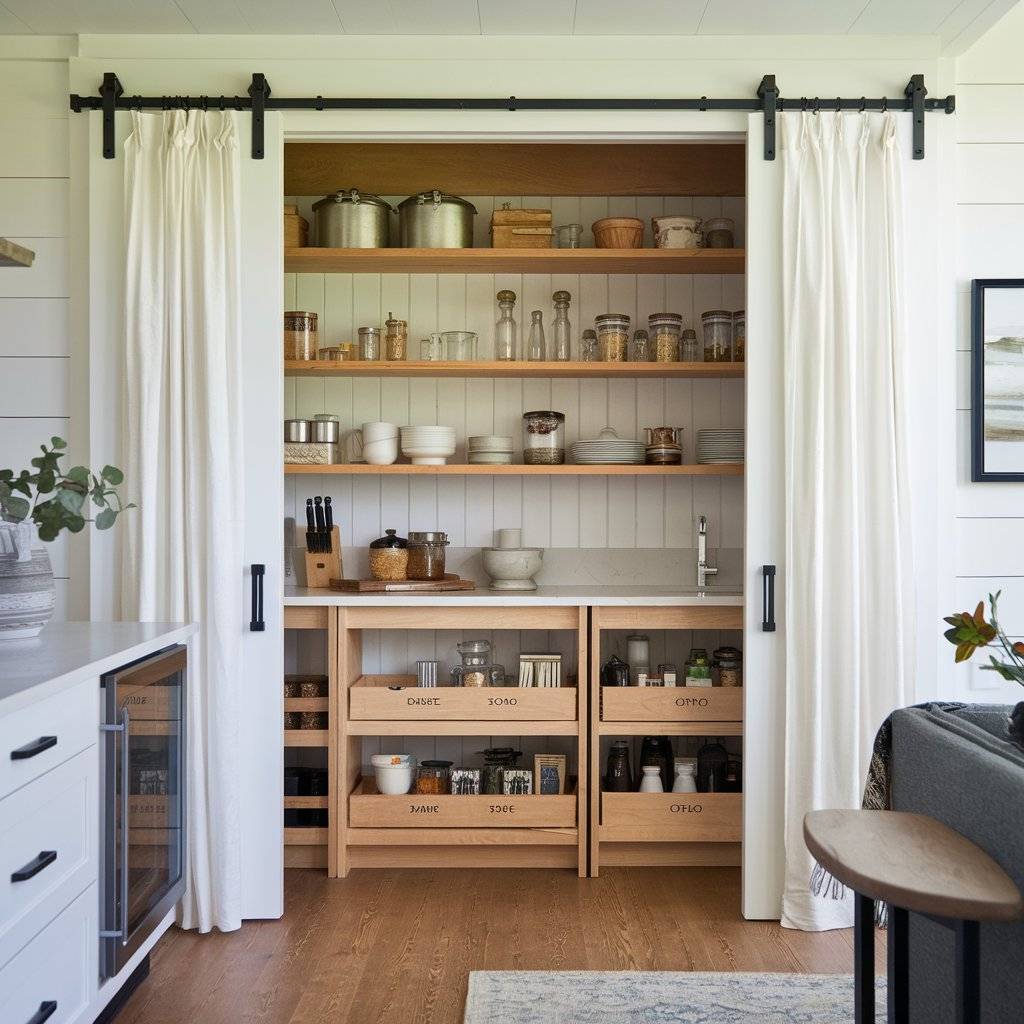
10. Add a Serving Hatch
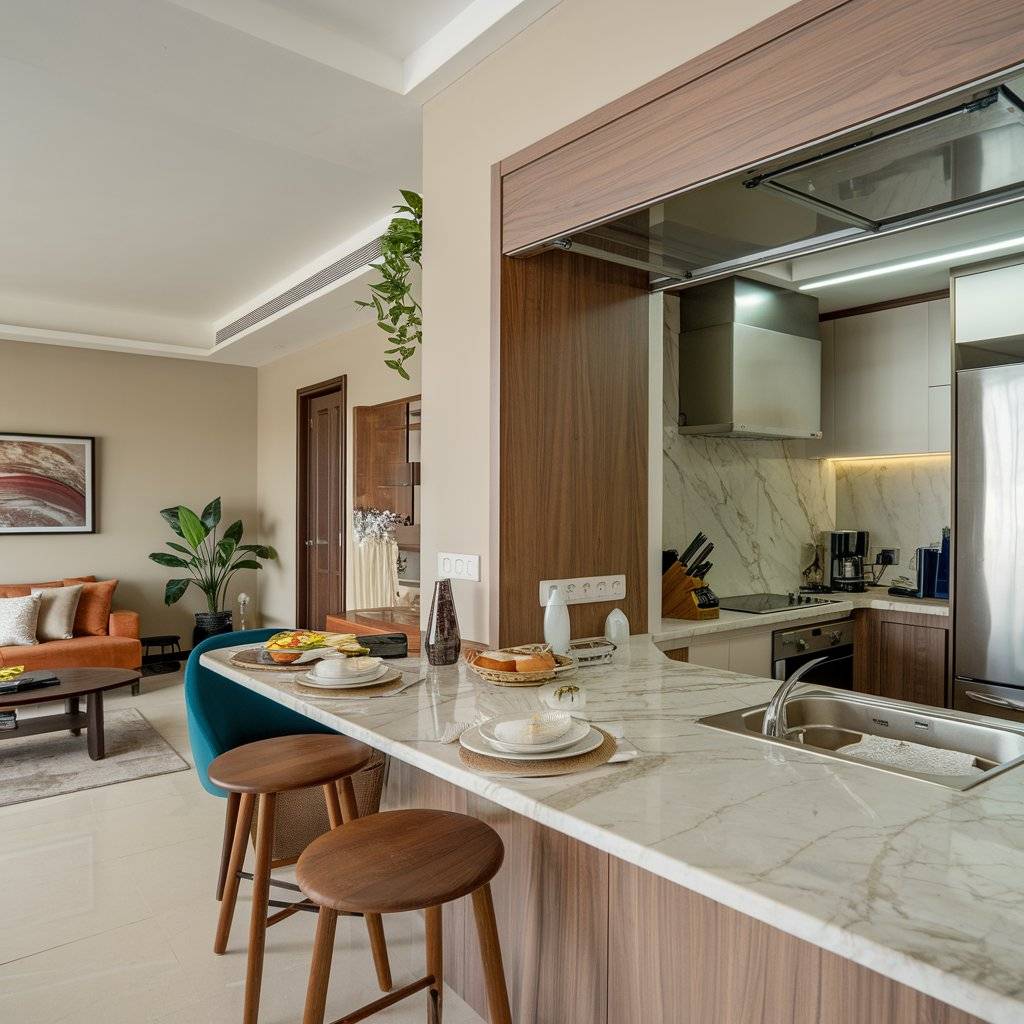
A serving hatch provides connectivity while still keeping distinct zones, allowing easy meal transfer between areas. A serving hatch is a practical and stylish addition to any home, especially in open-plan or compact spaces.
It enhances communication between the kitchen and dining area while maintaining separation, reducing noise and cooking odors.
Ideal for entertaining, a serving hatch streamlines meal service and cleanup, making dining more efficient and enjoyable. It can also be designed with sliding panels or decorative framing to complement your home’s aesthetic.
A serving hatch allows easy meal transfer while maintaining separation.
Amazon Affiliate Link: Best Kitchen Pass-Through Windows
Product Information:
- Material: Wood, metal framing, glass
- Placement: Between kitchen and dining/living area
- Accessibility: Smooth pass-through functionality
9. Choose Minimalist Design for a Seamless Look
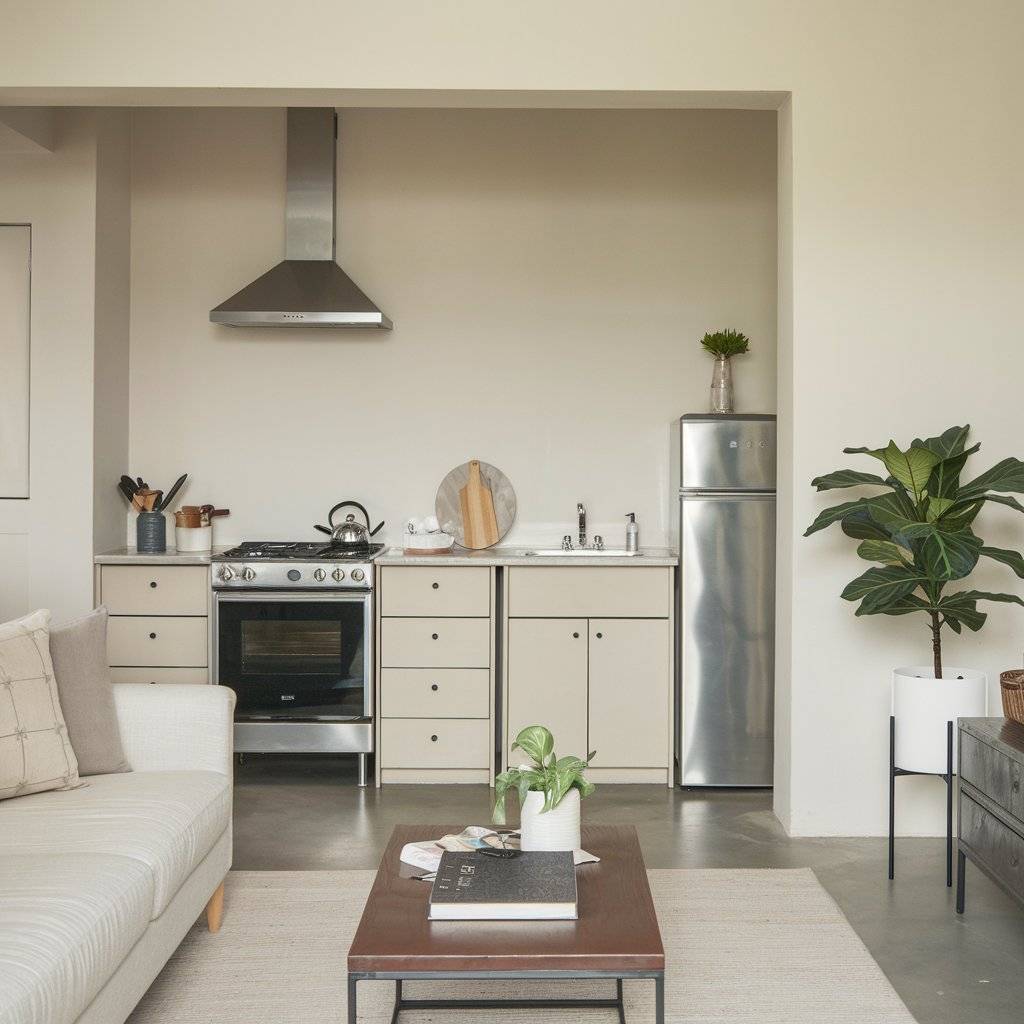
A clutter-free, minimalist approach creates a smooth and uninterrupted flow between the two areas. A minimalist design emphasizes clean lines, neutral colors, and simple furnishings, making the kitchen and dining area feel like a cohesive space.
By reducing visual distractions, such as excessive décor or bulky furniture, the transition between the two areas becomes seamless.
Opt for built-in storage, streamlined cabinetry, and a neutral color palette to maintain a harmonious and open atmosphere.
A clutter-free approach enhances openness.
Amazon Affiliate Link: Minimalist Kitchen Decor
Technical Details:
- Aesthetic: Clutter-free, simple, neutral tones
- Storage: Concealed, sleek cabinets
- Focus: Functionality with clean lines
8. Incorporate a Butler’s Pantry
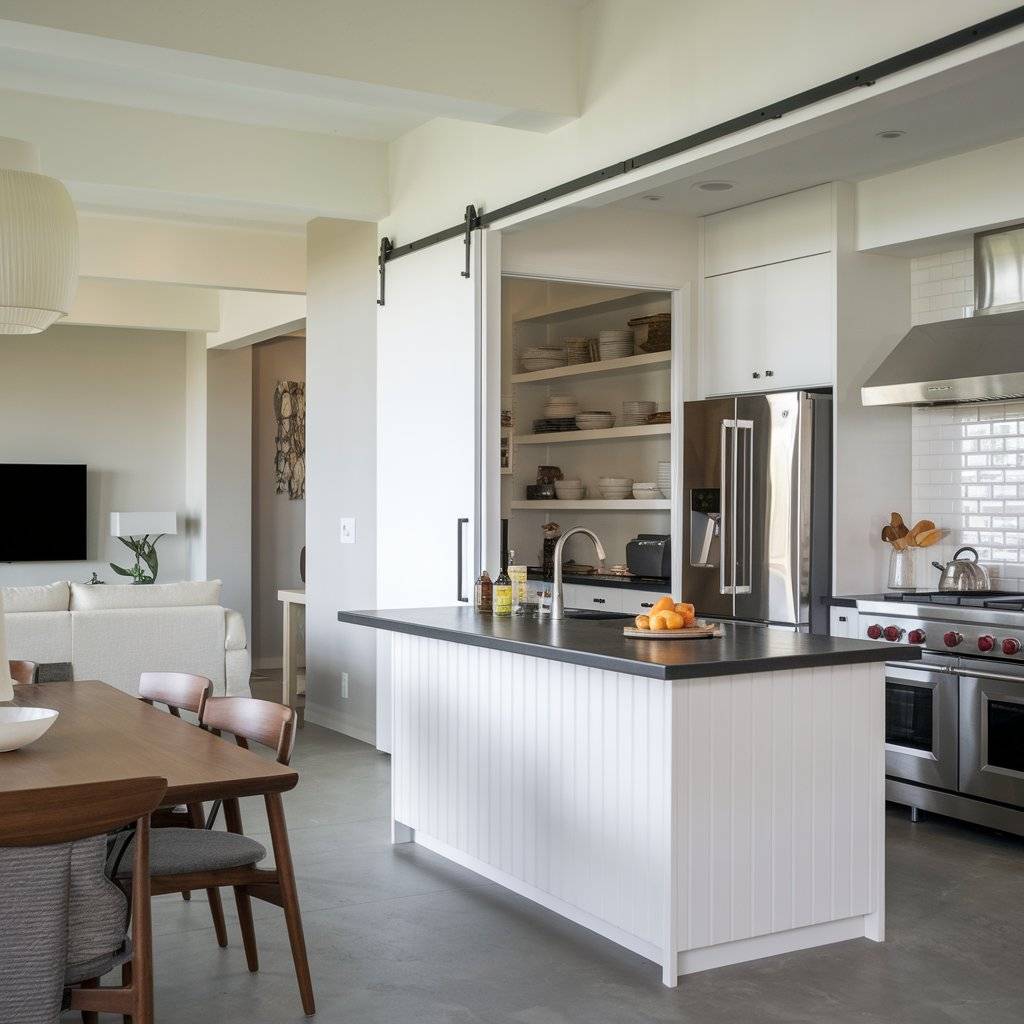
A hidden butler’s pantry offers extra storage and prep space, keeping the main area clean and organized. A butler’s pantry is a functional extension of your kitchen, often tucked away behind a sliding door or within a hallway nook.
It provides additional counter space for meal prep, small appliances, and pantry storage, making it easier to keep your main kitchen clutter-free.
Equipped with shelves, cabinets, and sometimes a sink or second dishwasher, a butler’s pantry enhances efficiency, especially when entertaining guests.
A butler’s pantry provides extra storage and prep space.
Amazon Affiliate Link: Best Butler’s Pantry Storage Solutions
Technical Details:
- Storage: Extra shelving for appliances, dry goods
- Access: Hidden behind kitchen or near dining
- Utility: Keeps main space organized
7. Use a Waterfall Countertop
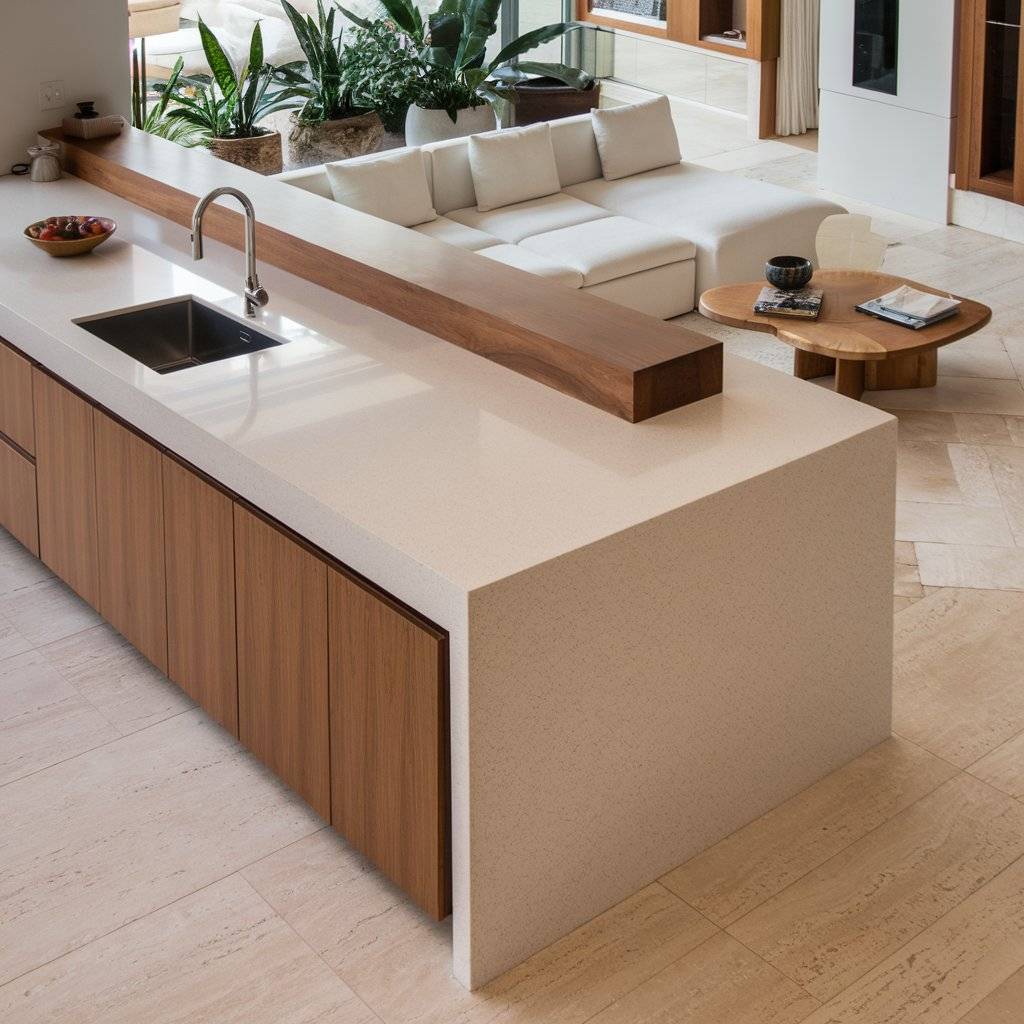
A sleek, waterfall-style kitchen counter extends the space elegantly into the living room, creating a cohesive look. This design features a continuous surface that flows seamlessly from the countertop down to the floor, adding a modern and luxurious touch.
Waterfall countertops work well with various materials like marble, quartz, or wood, offering both aesthetic appeal and durability. They also provide additional protection for cabinetry and can double as a stylish seating or dining area in open-concept spaces.
A waterfall-style kitchen counter creates a cohesive look.
Amazon Affiliate Link: Best Quartz Countertops
Product Information:
- Materials: Quartz, marble, granite
- Edge Design: Sleek, continuous flow
- Installation: Professional fitting recommended
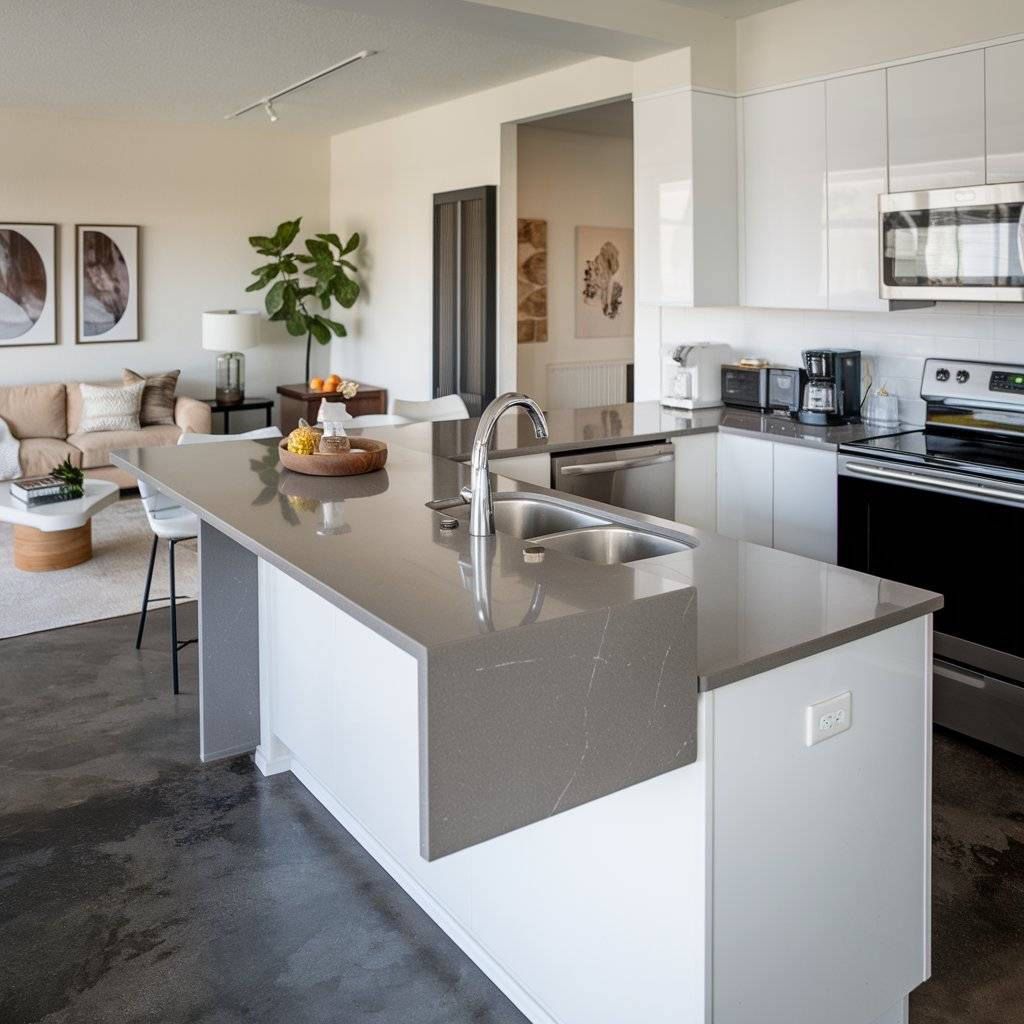
6. Include a Cozy Nook
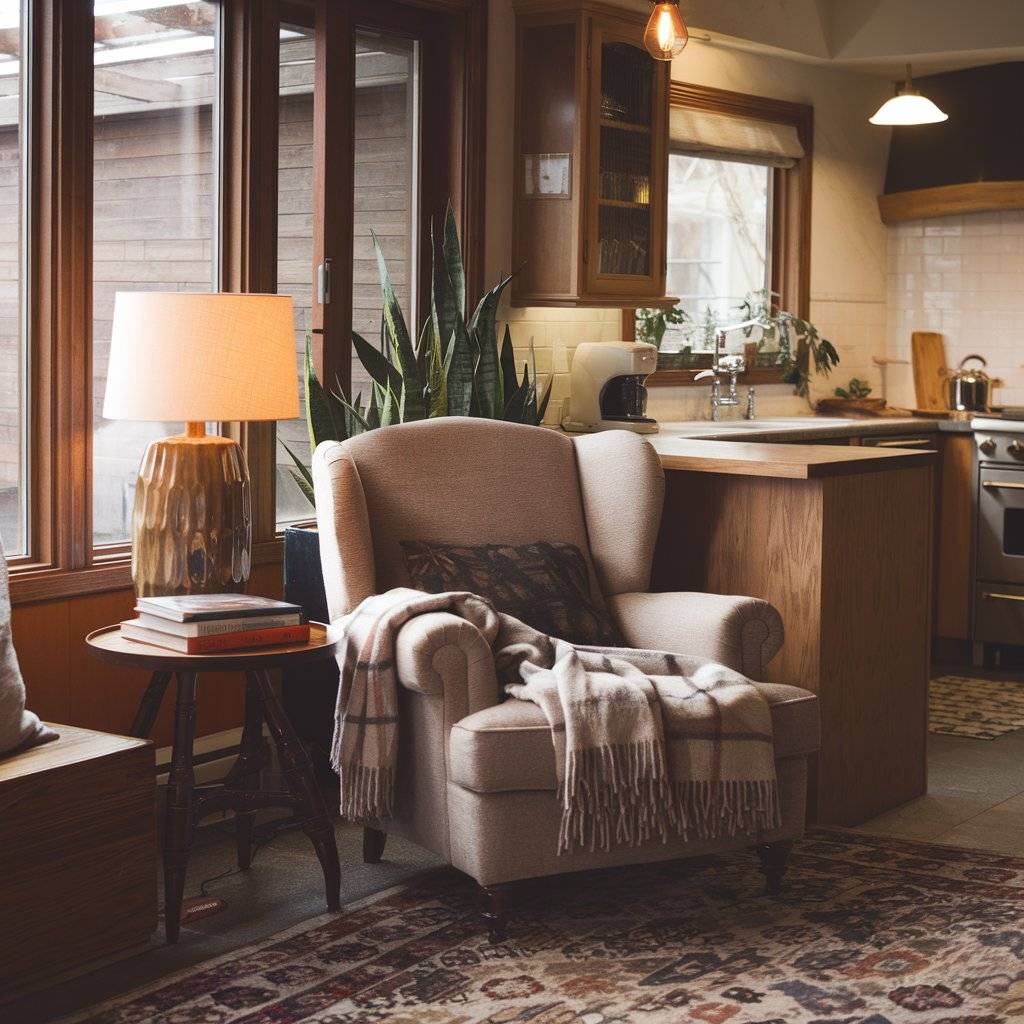
A small seating area or reading nook within the kitchen-living space fosters a warm and inviting atmosphere. In enhance this cozy nook with a plush armchair, soft throw blankets, and a small side table for books or a cup of tea.
Adding warm lighting, such as a table lamp or string lights, can create an inviting ambiance. Consider placing the nook near a window for natural light or incorporating built-in seating with cushions for a space-saving solution.
This dedicated area encourages relaxation and casual conversations, making the kitchen-living space feel even more welcoming.
A small seating area or reading nook fosters warmth.
Amazon Affiliate Link: Best Accent Chairs for Reading Nooks
Technical Details:
- Seating: Built-in benches, cushioned chairs
- Lighting: Soft ambient fixtures
- Location: Corner spaces, under windows
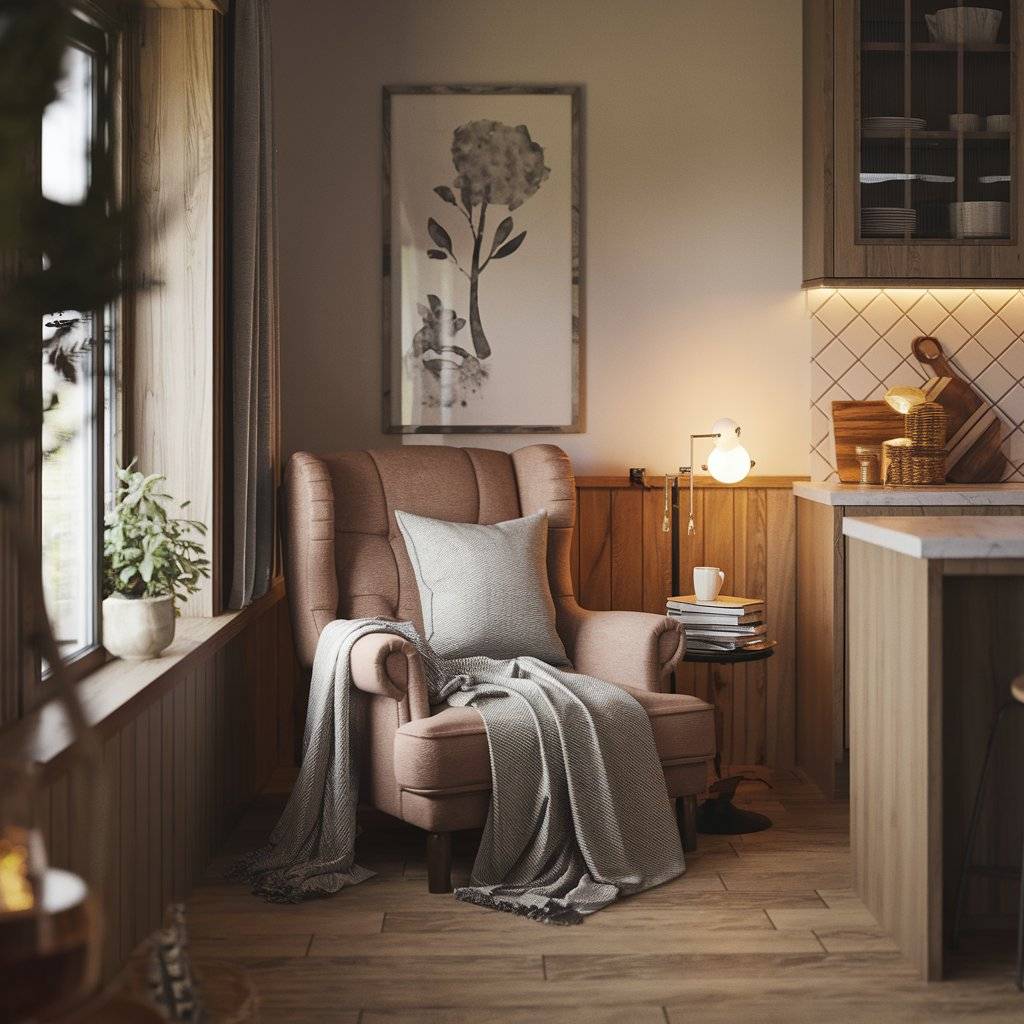
5. Opt for Smart Appliances
Modern, built-in smart appliances blend effortlessly, ensuring the kitchen doesn’t overpower the living space. These appliances offer advanced features like remote control, energy efficiency, and seamless integration with smart home systems.
From refrigerators with touchscreens to ovens with preset cooking modes, they enhance convenience while maintaining a sleek, minimalist aesthetic.
Built-in smart appliances enhance convenience and aesthetics.
Amazon Affiliate Link: Best Smart Refrigerators
Technical Details:
- Connectivity: Wi-Fi-enabled, voice control
- Efficiency: Energy-saving models
- Integration: Seamless built-in designs
4. Art and Decor to Tie the Spaces Together
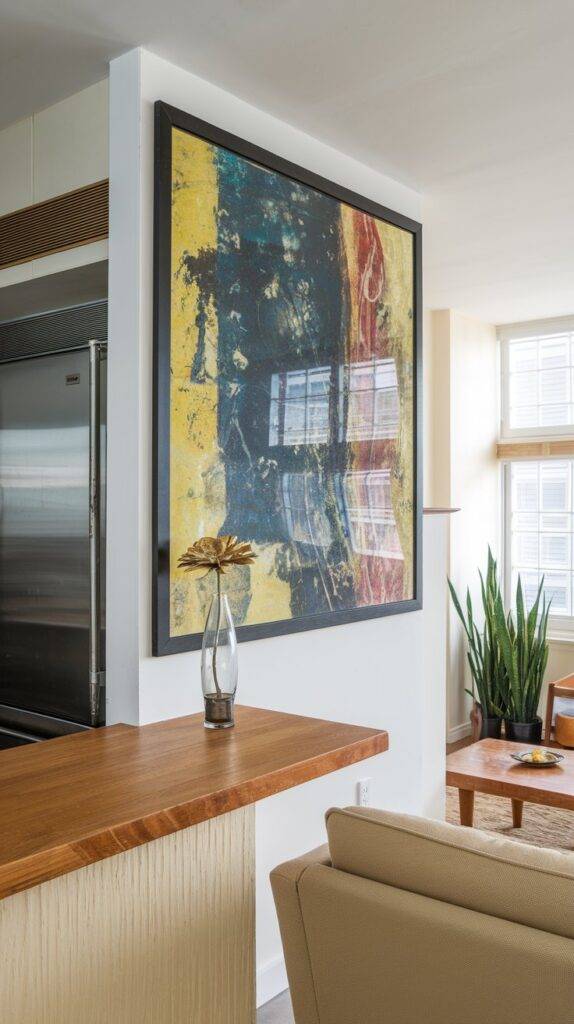
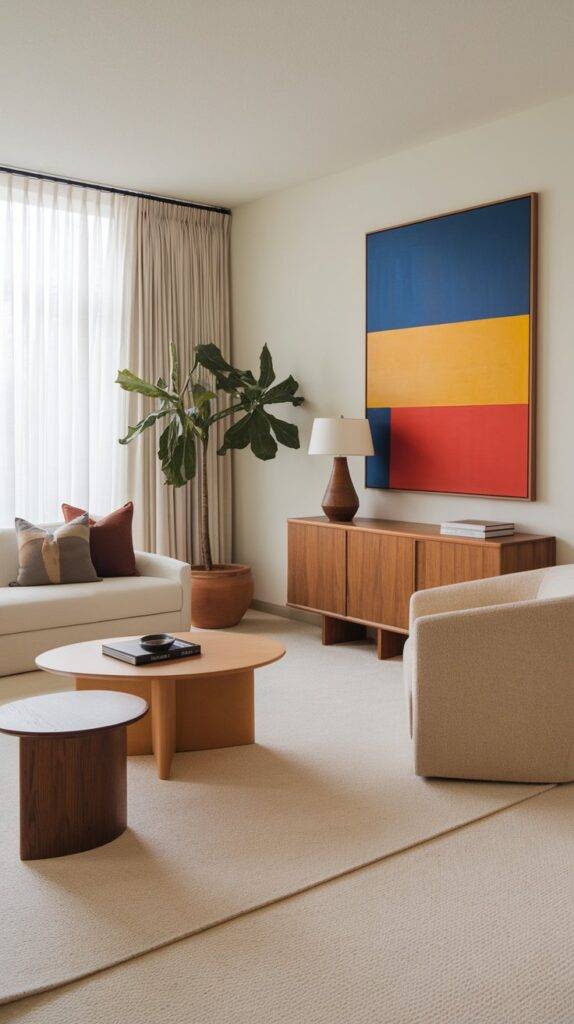
Incorporating art and decor strategically can help unify a space by reinforcing color schemes, themes, and textures.
Select artwork that complements your existing palette or introduces accent colors for balance. Decorative elements such as vases, sculptures, and textiles can echo shapes and patterns found in furniture, creating visual harmony.
To maintain cohesion, consider using a consistent framing style for artwork or arranging decor in a structured manner, such as symmetrical placements or grouped collections.
Strategically placed decor reinforces color schemes and themes.
Amazon Affiliate Link: Best Wall Art for Modern Homes
Technical Details:
- Types: Paintings, sculptures, accent pieces
- Theme: Complementary to kitchen-living aesthetics
- Placement: Walls, shelves, focal points
3. Use Reflective Surfaces for a Spacious Feel
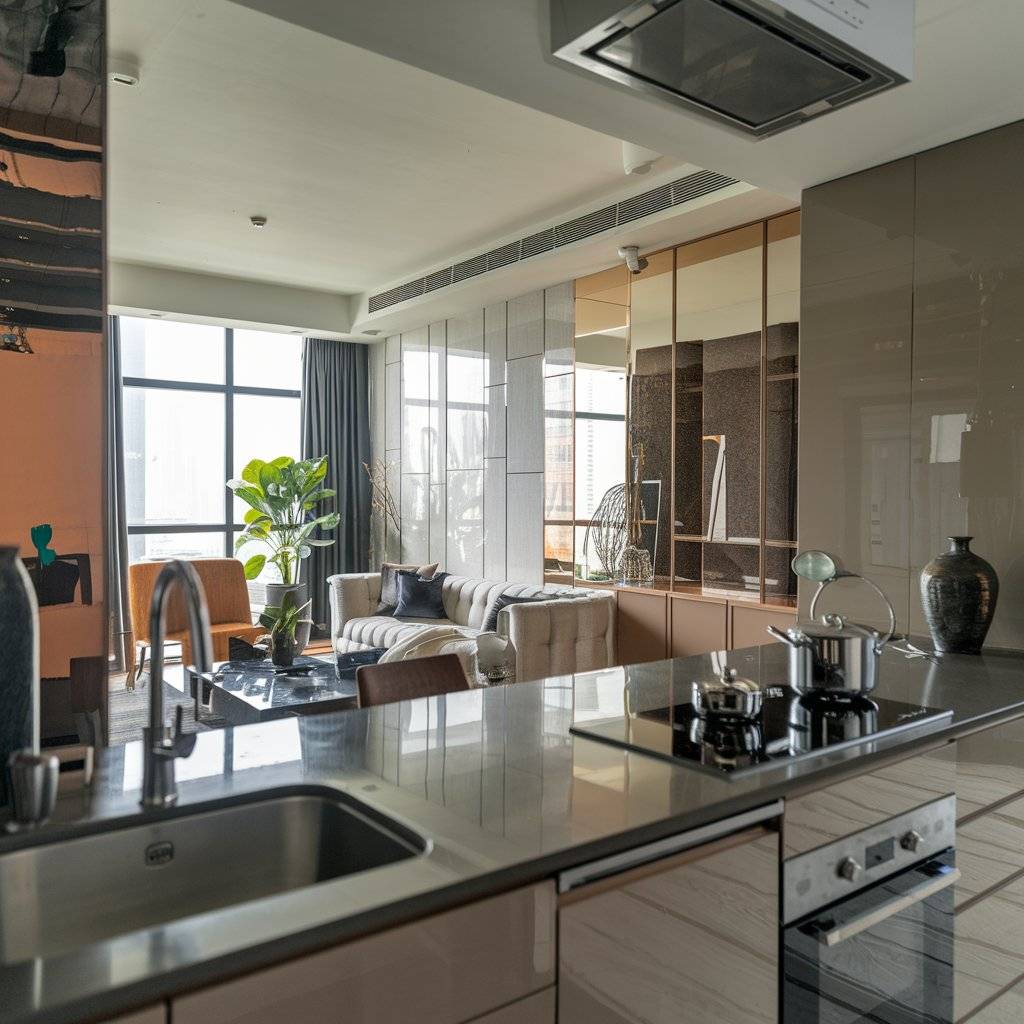
Glossy finishes, mirrors, and glass elements help bounce light around, making the space feel larger and more open. You can enhance this effect by strategically placing mirrors across from windows to maximize natural light.
Opt for glass tabletops, high-gloss cabinets, or metallic accents to add depth and brightness to the room. These reflective surfaces create an airy ambiance, making even compact spaces feel more expansive
Glossy finishes and mirrors make the space feel larger.
Amazon Affiliate Link: Best Large Decorative Mirrors
Technical Details:
- Materials: Glass, high-gloss cabinets, mirrors
- Light Reflection: Enhances brightness
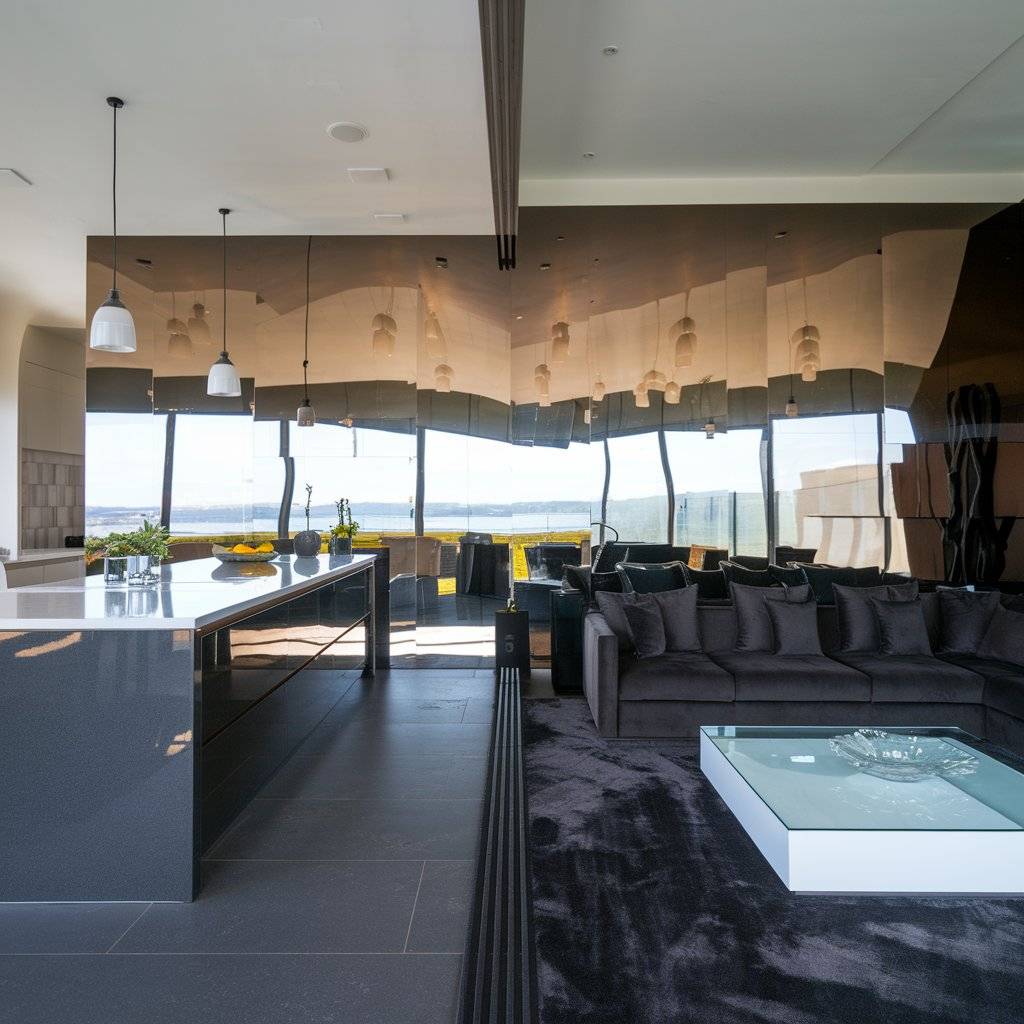
2. Create a Seamless Outdoor Extension
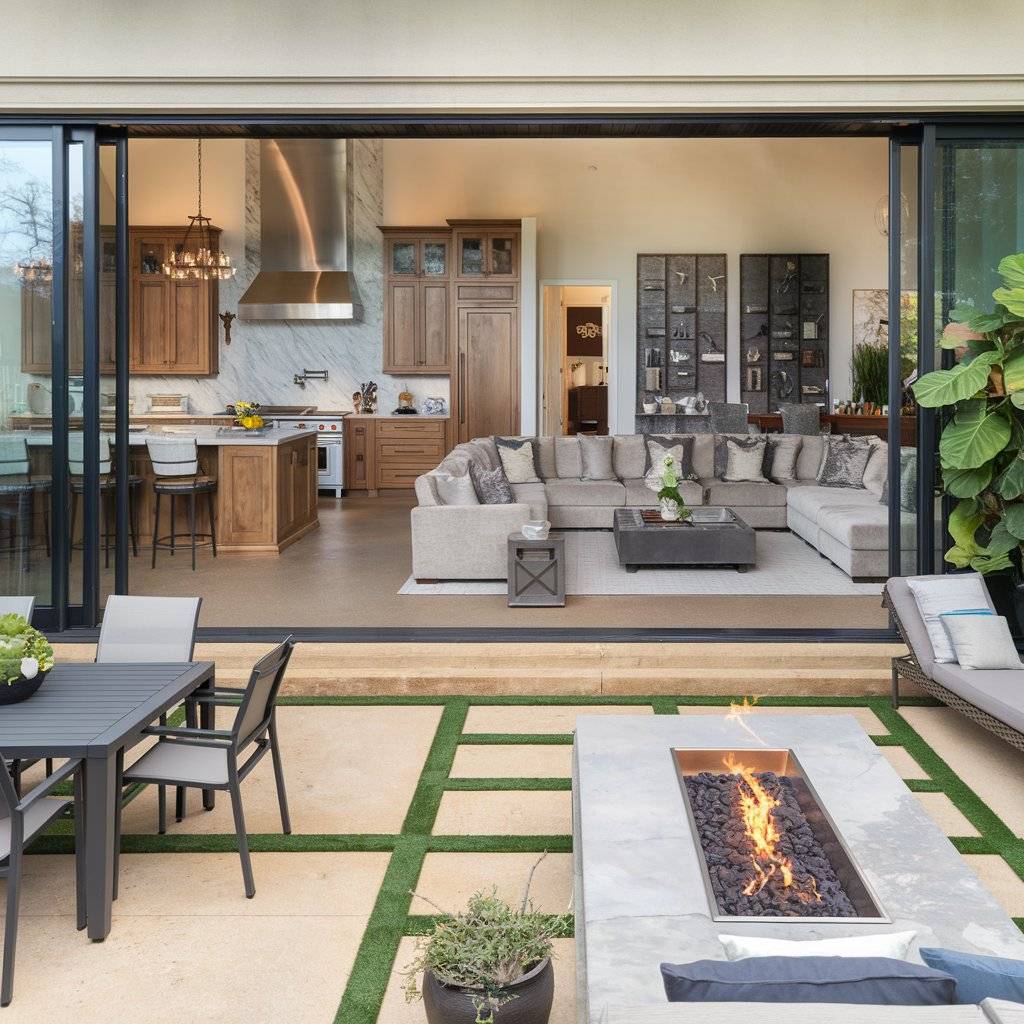
Connect the kitchen and living area to an outdoor patio with large glass doors enhances openness and functionality. This design not only maximizes natural light but also creates a fluid transition between indoor and outdoor spaces.
Opt for retractable or sliding glass doors to make the connection effortless, and consider matching flooring materials to unify the areas.
Adding comfortable outdoor seating, weather-resistant décor, and a dining space can further extend your living area, making it ideal for entertaining or relaxation.
Connecting the kitchen and living area to an outdoor patio enhances openness.
Amazon Affiliate Link: Best Sliding Patio Doors
Technical Details:
- Access: Sliding doors, bi-fold doors
- Flooring: Weather-resistant materials
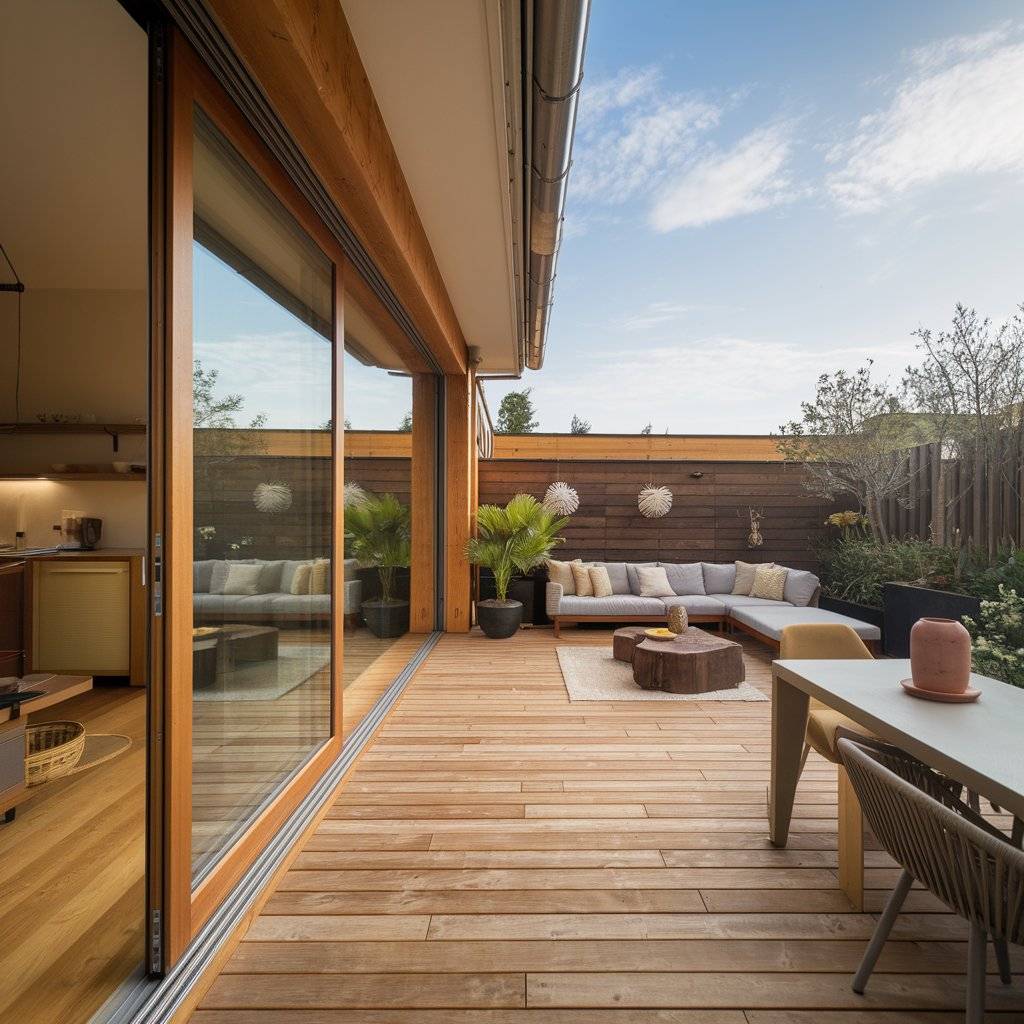
1. Personalize with Your Unique Style
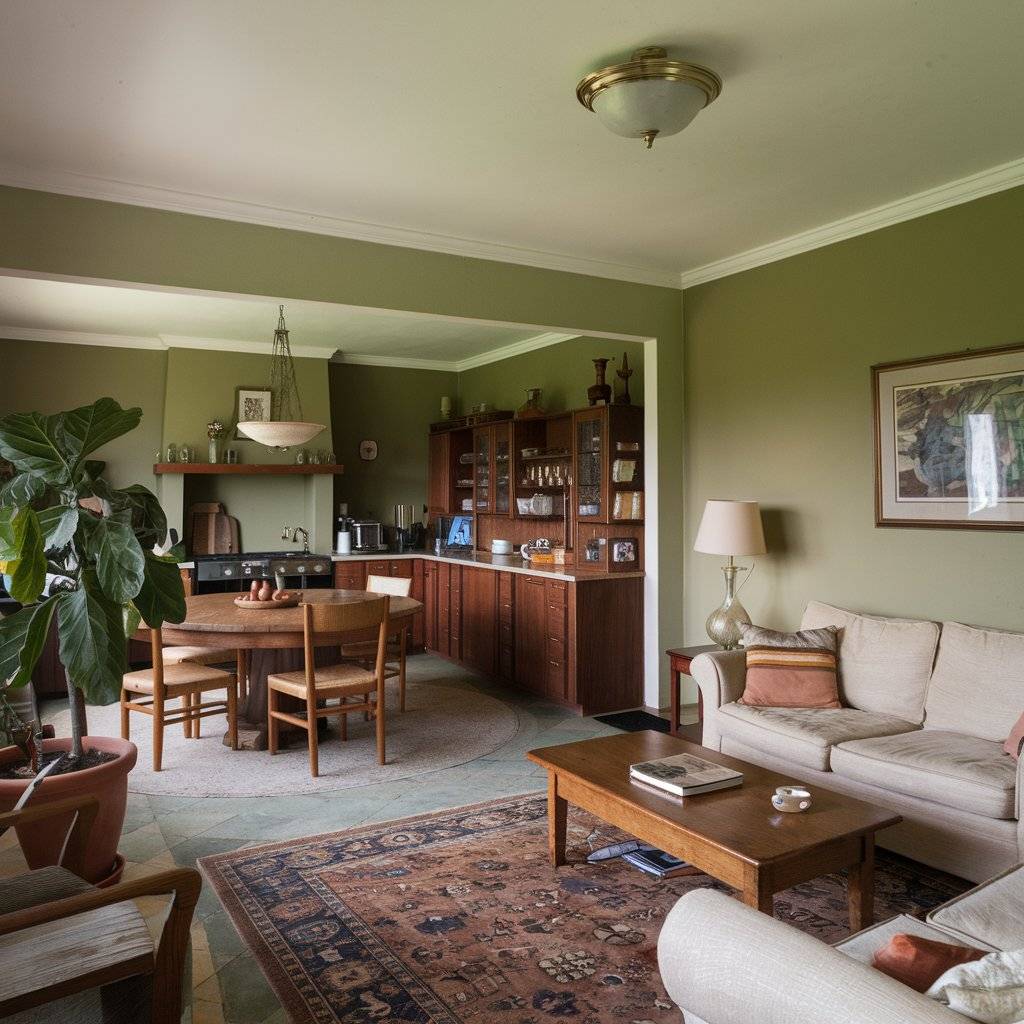
Your home should reflect your personality and taste. Consider adding custom-built elements like shelving or cabinetry tailored to your needs. Unique furniture pieces, whether vintage finds or modern statement pieces, can enhance character.
Bold design choices, such as accent walls, distinctive lighting fixtures, or artistic decor, help create a space that feels authentically yours. Personalization not only makes your home more enjoyable but also adds a sense of comfort and belonging.
Your home should reflect your personality and taste.
Amazon Affiliate Link: Best Custom Home Decor Items
Product Information & Technical Details:
- Customization: DIY decor, unique furniture
- Expression: Bold design choices
By implementing these 30 strategies, you can successfully create a stylish and functional open-concept kitchen-living space that enhances comfort, aesthetics, and practicality.
- Natural Wood Tables: Rustic & Eco-Friendly Furniture - December 8, 2025
- Enchanting Christmas Garden Designs for a Cozy, Festive Backyard - November 29, 2025
- 35 Best Open Layout Living Room Dining Room Designs - November 29, 2025

